May 5, 2022 · by harveyorgan · in Uncategorized · Leave a comment·Edit
May 5, 2022 · by harveyorgan · in Uncategorized · Leave a comment·Edit
GOLD; $1883.35 UP $7.95
SILVER: $22.38 DOWN $.06
ACCESS MARKET: GOLD $1883.85
SILVER: $22.36
Bitcoin morning price: $35,745 UP 133
Bitcoin: afternoon price: $35,909 UP 297
Platinum price: closing down $16.95 to $968.50
Palladium price; closing down 139.70 at $2048.00
END
DONATE
Click here if you wish to send a donation. I sincerely appreciate it as this site takes a lot of preparation
comex notices:336/425
EXCHANGE: COMEX
CONTRACT: MAY 2022 COMEX 100 GOLD FUTURES
SETTLEMENT: 1,874.000000000 USD
INTENT DATE: 05/05/2022 DELIVERY DATE: 05/09/2022
FIRM ORG FIRM NAME ISSUED STOPPED
132 C SG AMERICAS 2
435 H SCOTIA CAPITAL 2
657 H MORGAN STANLEY 54
661 C JP MORGAN 422 336
709 C BARCLAYS 25
732 C RBC CAP MARKETS 3
737 C ADVANTAGE 3 3
TOTAL: 425 425
MONTH TO DATE: 1,909
NUMBER OF NOTICES FILED TODAY FOR MAY CONTRACT 425 NOTICE(S) FOR 42,500 OZ (1.3219 TONNES)
total notices so far: 1909 contracts for 190,900. oz (5.9377 tonnes)
SILVER NOTICES:
782 NOTICE(S) FILED 3910,000 OZ/
total number of notices filed so far this month 3620 : for 18,100,000 oz
END
Russia is a major supplier of silver to London while Mexico supplies the COMEX
With the sanctions, London has no way to obtain silver other than compete with NY.
END
GLD
WITH GOLD UP $7.95
WITH RESPECT TO GLD WITHDRAWALS: (OVER THE PAST FEW MONTHS):
GOLD IS “RETURNED” TO THE BANK OF ENGLAND WHEN CALLING IN THEIR LEASES: THE GOLD NEVER LEAVES THE BANK OF ENGLAND IN THE FIRST PLACE. THE BANK IS PROTECTING ITSELF IN CASE OF COMMERCIAL FAILURE
ALSO INVESTORS SWITCHING TO SPROTT PHYSICAL (phys) INSTEAD OF THE FRAUDULENT GLD//
A HUGE CHANGE IN GOLD INVENTORY AT THE GLD: A WITHDRAWAL OF 4.06 TONNESE FROM THE GLD
INVENTORY RESTS AT 1084.98 TONNES
Silver//SLV
WITH NO SILVER AROUND AND SILVER DOWN 6 CENTS
CENTS
AT THE SLV// A SMALL CHANGE IN SILVER INVENTORY AT THE SLV://A WITHDRAWAL OF .9300 MILLION OZ INTO THE SLV/
INVESTORS ARE SWITCHING SLV TO SPROTT’S PSLV
CLOSING INVENTORY: 575.977 MILLION OZ
Let us have a look at the data for today
SILVER//OUTLINE
SILVER COMEX OI ROSE BY A HUGE SIZED 2098 CONTRACTS TO 141,590 AND CLOSER TO THE NEW RECORD OF 244,710, SET FEB 25/2020 AND THE GAIN IN OI WAS ACCOMPLISHED DESPITE OUR TINY $0.06 GAIN IN SILVER PRICING AT THE COMEX ON THURSDAY. OUR BANKERS WERE UNSUCCESSFUL IN KNOCKING THE PRICE OF SILVER DOWN (IT ROSE BY $0.06) AND WERE UNSUCCESSFUL IN KNOCKING OUT ANY SILVER LONGS AS WE HAD A HUMONGOUS GAIN OF 5768 CONTRACTS ON OUR TWO EXCHANGES.
WE MUST HAVE HAD:
I) HUGE BANKER SHORT COVERING AS THEY ARE VERY ANXIOUS TO GET OUT OF DODGE!!/. II)WE ALSO HAD SOME REDDIT RAPTOR BUYING//. iii) A STRONG ISSUANCE OF EXCHANGE FOR PHYSICALS iiii) A STRONG INITIAL SILVER STANDING FOR COMEX SILVER MEASURING AT 30.170 MILLION OZ FOLLOWED BY TODAY’S 40,000 OZ QUEUE JUMP //NEW STANDING 28.600 MILLION OZ/ // V) HUGE SIZED COMEX OI GAIN/
I AM NOW RECORDING THE DIFFERENTIAL IN OI FROM PRELIMINARY TO FINAL:
THE DIFFERENTIAL FROM PRELIMINARY OI TO FINAL OI SILVER TODAY: CONTRACTS : -2415
HISTORICAL ACCUMULATION OF EXCHANGE FOR PHYSICALS MAY. ACCUMULATION FOR EFP’S SILVER/JPMORGAN’S HOUSE OF BRIBES/STARTING FROM FIRST DAY/MONTH OF MAY:
TOTAL CONTACTS for 5days, total 6316, contracts: 31.580 million oz OR 6.316 MILLION OZ PER DAY. (1263CONTRACTS PER DAY)
TOTAL EFP’S FOR THE MONTH SO FAR: 31.480 MILLION OZ
.
LAST 11 MONTHS TOTAL EFP CONTRACTS ISSUED IN MILLIONS OF OZ:
MAY 137.83 MILLION
JUNE 149.91 MILLION OZ
JULY 129.445 MILLION OZ
AUGUST: MILLION OZ 140.120
SEPT. 28.230 MILLION OZ//
OCT: 94.595 MILLION OZ
NOV: 131.925 MILLION OZ
DEC: 100.615 MILLION OZ
JAN 2022// 90.460 MILLION OZ
FEB 2022: 72.39 MILLION OZ//
MARCH: 207.430 MILLION OZ//A NEW RECORD FOR EFP ISSUANCE AND WE ARE STILL GOING STRONG THIS MONTH.
APRIL: 114.52 MILLION OZ FINAL//LOW ISSUANCE
MAY: 31.580 MILLION OZ//INCREASING AGAIN
RESULT: WE HAD A HUGE SIZED INCREASE IN COMEX OI SILVER COMEX CONTRACTS OF 2098 DESPITE OUR TINY $0.06 GAIN IN SILVER PRICING AT THE COMEX// THURSDAY., TODAY. THE CME NOTIFIED US THAT WE HAD A STRONG SIZED EFP ISSUANCE CONTRACTS: 1255 CONTRACTS ISSUED FOR MAY AND 0 CONTRACTS ISSUED FOR ALL OTHER MONTHS) WHICH EXITED OUT OF THE SILVER COMEX TO LONDON AS FORWARDS THE DOMINANT FEATURE TODAY: /HUGE BANKER SHORT COVERING AS THEY GET OUT OF DODGE//// WE HAVE A HUGE INITIAL SILVER OZ STANDING FOR MAY. OF 30.170 MILLION OZ FOLLOWED BY TODAY;S 40,000 OZ QUEUE JUMP//NEW STANDING 28.60 MILLION OZ// .. WE HAD A HUMONGOUS SIZED GAIN OF 3353 OI CONTRACTS ON THE TWO EXCHANGES FOR 28.84 MILLION OZ DESPITE THE SMALL GAIN IN PRICE.
WE HAD 782 NOTICE FILED TODAY FOR 3,910,000 OZ
THE SILVER COMEX IS NOW BEING ATTACKED FOR METAL BY LONDONERS ET AL.
GOLD//OUTLINE
IN GOLD, THE COMEX OPEN INTEREST ROSE BY A HUGE SIZED 4,787 CONTRACTS TO 573,773 AND CLOSER TO NEW RECORD (SET JAN 24/2020) AT 799,541 AND PREVIOUS TO THAT: (SET JAN 6/2020) AT 797,110.
THE DIFFERENTIAL FROM PRELIMINARY OI TO FINAL OI IN GOLD TODAY: –9938 CONTRACTS. WHAT AN ABSOLUTE FRAUD!!
THE BIS HAS ABANDONED THE GOLD COMEX TRADING!!!
.
THE GOOD SIZED INCREASE IN COMEX OI CAME WITH OUR GAIN IN PRICE OF $6.60//COMEX GOLD TRADING/THURSDAY /.AS IN SILVER WE MUST HAD HUGE BANKER/ALGO SHORT COVERING ACCOMPANYING OUR FAIR SIZED EXCHANGE FOR PHYSICAL ISSUANCE. WE HAD ZERO LONG LIQUIDATION
WE ALSO HAD A HUGE INITIAL STANDING IN GOLD TONNAGE FOR MAY AT 5.353 TONNES ON FIRST DAY NOTICE /FOLLOWED BY TODAY”S QUEUE JUMP OF 3900 OZ//NEW STANDING 7,589 TONNES
YET ALL OF..THIS HAPPENED WITH OUR GAIN IN PRICE OF $6,60 WITH RESPECT TO THURSDAY’S TRADING
WE HAD A STRONG SIZED GAIN OF 8,506 OI CONTRACTS (26.457 PAPER TONNES) ON OUR TWO EXCHANGES..
E.F.P. ISSUANCE
THE CME RELEASED THE DATA FOR EFP ISSUANCE AND IT TOTALED A FAIR SIZED 3719 CONTRACTS:
The NEW COMEX OI FOR THE GOLD COMPLEX RESTS AT 573,733.
IN ESSENCE WE HAVE A STRONG SIZED INCREASE IN TOTAL CONTRACTS ON THE TWO EXCHANGES OF 8,506, WITH 4,787 CONTRACTS INCREASED AT THE COMEX AND 3719 EFP OI CONTRACTS WHICH NAVIGATED OVER TO LONDON. THUS TOTAL OI GAIN ON THE TWO EXCHANGES OF 8,506 CONTRACTS OR 26.457 TONNES.
CALCULATIONS ON GAIN/LOSS ON OUR TWO EXCHANGES
WE HAD A GOOD SIZED ISSUANCE IN EXCHANGE FOR PHYSICALS (3719) ACCOMPANYING THE GOOD SIZED GAIN IN COMEX OI (4,7287,): TOTAL GAIN IN THE TWO EXCHANGES 8,506 CONTRACTS. WE NO DOUBT HAD 1) HUGE BANKER SHORT COVERING ,2.) STRONG INITIAL STANDING AT THE GOLD COMEX FOR MAY. AT 5.353 TONNES FOLLOWED BY TODAY’S QUEUE JUMP OF 3700 OZ//NEW STANDING 7.589 /// 3) ZERO LONG LIQUIDATION //.,4) GOOD SIZED COMEX OI. GAIN 5) GOOD ISSUANCE OF EXCHANGE FOR PHYSICAL/
HISTORICAL ACCUMULATION OF EXCHANGE FOR PHYSICALS IN 2022 INCLUDING TODAY
MAY
ACCUMULATION OF EFP’S GOLD AT J.P. MORGAN’S HOUSE OF BRIBES: (EXCHANGE FOR PHYSICAL) FOR THE MONTH OF MAY :
14,061 CONTRACTS OR 1,406,100 OR 43.74 TONNES 5 TRADING DAY(S) AND THUS AVERAGING: 2812 EFP CONTRACTS PER TRADING DAY
TO GIVE YOU AN IDEA AS TO THE SIZE OF THESE EFP TRANSFERS : THIS MONTH IN 5 TRADING DAY(S) IN TONNES: 43.74 TONNES
TOTAL ANNUAL GOLD PRODUCTION, 2021, THROUGHOUT THE WORLD EX CHINA EX RUSSIA: 3555 TONNES
THUS EFP TRANSFERS REPRESENTS 43.74/3550 x 100% TONNES 1.23% OF GLOBAL ANNUAL PRODUCTION
ACCUMULATION OF GOLD EFP’S YEAR 2021 TO 2022
JANUARY/2021: 265.26 TONNES (RAPIDLY INCREASING AGAIN)
FEB : 171.24 TONNES ( DEFINITELY SLOWING DOWN AGAIN)..
MARCH:. 276.50 TONNES (STRONG AGAIN/
APRIL: 189..44 TONNES ( DRAMATICALLY SLOWING DOWN AGAIN//GOLD IN BACKWARDATION)
MAY: 250.15 TONNES (NOW DRAMATICALLY INCREASING AGAIN)
JUNE: 247.54 TONNES (FINAL)
JULY: 188.73 TONNES FINAL
AUGUST: 217.89 TONNES FINAL ISSUANCE.
SEPT 142.12 TONNES FINAL ISSUANCE ( LOW ISSUANCE)_
OCT: 141.13 TONNES FINAL ISSUANCE (LOW ISSUANCE)
NOV: 312.46 TONNES FINAL ISSUANCE//NEW RECORD!! (INCREASING DRAMATICALLY)//SIGN OF REAL STRESS//SURPASSING THE MARCH 2021 RECORD OF 276.50 TONNES OF EFP
DEC. 175.62 TONNES//FINAL ISSUANCE//
JAN:2022 247.25 TONNES //FINAL
FEB: 196.04 TONNES//FINAL
MARCH: 409.30 TONNES INITIAL( THIS IS NOW A RECORD EFP ISSUANCE FOR MARCH AND FOR ANY MONTH.
APRIL: 169.55 TONNES (FINAL VERY LOW ISSUANCE MONTH)
MAY: 43.74 TONNES INITIAL//SLIGHTLY INCREASING AGGAIN
SPREADING OPERATIONS
(/NOW SWITCHING TO GOLD) FOR NEWCOMERS, HERE ARE THE DETAILS
SPREADING LIQUIDATION HAS NOW COMMENCED AS WE HEAD TOWARDS THE NEW ACTIVE FRONT MONTH OF MAY.WE ARE NOW INTO THE SPREADING OPERATION OF SILVER
HERE IS A BRIEF SYNOPSIS OF HOW THE CROOKS FLEECE UNSUSPECTING LONGS IN THE SPREADING ENDEAVOUR ;MODUS OPERANDI OF THE CORRUPT BANKERS AS TO HOW THEY HANDLE THEIR SPREAD OPEN INTERESTS:HERE IS HOW THE CROOKS USED SPREADING AS WE ARE NOW INTO THE NON ACTIVE DELIVERY MONTH OF APRIL HEADING TOWARDS THE ACTIVE DELIVERY MONTH OF MAY, FOR SILVER:
YOU WILL ALSO NOTICE THAT THE COMEX OPEN INTEREST STARTS TO RISE BUT SO IS THE OPEN INTEREST OF SPREADERS. THE OPEN INTEREST IN WILL CONTINUE TO RISE UNTIL ONE WEEK BEFORE FIRST DAY NOTICE OF AN UPCOMING ACTIVE DELIVERY MONTH (MAR), AND THAT IS WHEN THE CROOKS SELL THEIR SPREAD POSITIONS BUT NOT AT THE SAME TIME OF THE DAY. THEY WILL USE THE SELL SIDE OF THE EQUATION TO CREATE THE CASCADE (ALONG WITH THEIR COLLUSIVE FRIENDS) AND THEN COVER ON THE BUY SIDE OF THE SPREAD SITUATION AT THE END OF THE DAY. THEY DO THIS TO AVOID POSITION LIMIT DETECTION. THE LIQUIDATION OF THE SPREADING FORMATION CONTINUES FOR EXACTLY ONE WEEK AND ENDS ON FIRST DAY NOTICE.”
WHAT IS ALARMING TO ME, ACCORDING TO OUR LONDON EXPERT ANDREW MAGUIRE IS THAT THESE EFP’S ARE BEING TRANSFERRED TO WHAT ARE CALLED SERIAL FORWARD CONTRACT OBLIGATIONS AND THESE CONTRACTS ARE LESS THAN 14 DAYS. ANYTHING GREATER THAN 14 DAYS, THESE MUST BE RECORDED AND SENT TO THE COMPTROLLER, GREAT BRITAIN TO MONITOR RISK TO THE BANKING SYSTEM. IF THIS IS INDEED TRUE, THEN THIS IS A MASSIVE CONSPIRACY TO DEFRAUD AS WE NOW WITNESS A MONSTROUS TOTAL EFP’S ISSUANCE AS IT HEADS INTO THE STRATOSPHERE.
First, here is an outline of what will be discussed tonight:
1.Today, we had the open interest at the comex, in SILVER, ROSE BY A STRONG SIZED 2098 CONTRACT OI TO 141,590 AND CLOSER TO OUR COMEX RECORD //244,710(SET FEB 25/2020). THE LAST RECORDS WERE SET IN AUG.2018 AT 244,196 WITH A SILVER PRICE OF $14.78/(AUGUST 22/2018)..THE PREVIOUS RECORD TO THAT WAS SET ON APRIL 9/2018 AT 243,411 OPEN INTEREST CONTRACTS WITH THE SILVER PRICE AT THAT DAY: $16.53). AND PREVIOUS TO THAT, THE RECORD WAS ESTABLISHED AT: 234,787 CONTRACTS, SET ON APRIL 21.2017 OVER 5 YEARS AGO.
EFP ISSUANCE 1255 CONTRACTS
OUR CUSTOMARY MIGRATION OF COMEX LONGS CONTINUE TO MORPH INTO LONDON FORWARDS AS OUR BANKERS USED THEIR EMERGENCY PROCEDURE TO ISSUE:
MAY 1255 ALL OTHER MONTHS: ZERO. TOTAL EFP ISSUANCE: 0 CONTRACTS. EFP’S GIVE OUR COMEX LONGS A FIAT BONUS PLUS A DELIVERABLE PRODUCT OVER IN LONDON. IF WE TAKE THE COMEX OI GAIN OF 2098 CONTRACTS AND ADD TO THE 1255 OI TRANSFERRED TO LONDON THROUGH EFP’S,
WE OBTAIN A HUGE SIZED GAIN OF 3353 OPEN INTEREST CONTRACTS FROM OUR TWO EXCHANGES.
THUS IN OUNCES, THE HUGE GAIN ON THE TWO EXCHANGES 16.764 MILLION OZ
OCCURRED DESPITE OUR LOSS IN PRICE OF $0.23 IN PRICE.
OUTLINE FOR TODAY’S COMMENTARY
1/COMEX GOLD AND SILVER REPORT
(report Harvey)
2 ) Gold/silver trading overnight Europe,
(Peter Schiff,
3. Egon von Greyerz///Matthew Piepenburg via GoldSwitzerland.com,
4. Chris Powell of GATA provides to us very important physical commentaries
end
5. Other gold commentaries
end
6. Commodity commentaries/cryptocurrencies
3. ASIAN AFFAIRS
i)THURSDAY MORNING// WEDNESDAY NIGHT
SHANGHAI CLOSED UP 20.70 PTS OR .68% //Hang Sang CLOSED DOWN 76.12 OR 0.36% /The Nikkei closed //Australia’s all ordinaires CLOSED UP .98% /Chinese yuan (ONSHORE) closed DOWN TO 6.6200 /Oil UP TO 108.12 dollars per barrel for WTI and UP TO 111.04 for Brent. Stocks in Europe OPENED ALL GREEN // ONSHORE YUAN CLOSED DOWN AGAINST THE DOLLAR AT 6.6200 OFFSHORE YUAN CLOSED UP ON THE DOLLAR AT 6.6525: /ONSHORE YUAN TRADING ABOVE LEVEL OF OFFSHORE YUAN/ONSHORE YUAN TRADING STRONGER AGAINST US DOLLAR/OFFSHORE STRONGER//
a)NORTH KOREA
outline
b) REPORT ON JAPAN/
OUTLINE
3 C CHINA
OUTLINE
4/EUROPEAN AFFAIRS
OUTLINE
5. RUSSIAN AND MIDDLE EASTERN AFFAIRS
OUTLINE
6.Global Issues
OUTLINE
7. OIL ISSUES
OUTLINE
8 EMERGING MARKET ISSUES
COMEX DATA//AMOUNTS STANDING//VOLUME OF TRADING/INVENTORY MOVEMENTS
GOLD
LET US BEGIN:
THE TOTAL COMEX GOLD OPEN INTEREST ROSE BY A GOOD SIZED 4,787 CONTRACTS TO 573,773 AND CLOSER TO THE RECORD THAT WAS SET IN JANUARY/2020: {799,541 OI(SET JAN 16/2020)} AND PREVIOUS TO THAT: 797,110 (SET JAN 7/2020). AND THIS COMEX INCREASE OCCURRED WITH OUR SMALLISH GAIN OF $6.60 IN GOLD PRICING THURSDAY’S COMEX TRADING. WE ALSO HAD A GOOD SIZED EFP (3719 CONTRACTS). . THEY WERE PAID HANDSOMELY NOT TO TAKE DELIVERY AT THE COMEX AND SETTLE FOR CASH.
WE NORMALLY HAVE WITNESSED EXCHANGE FOR PHYSICALS ISSUED BEING SMALL AS IT JUST TOO COSTLY FOR THEM TO CONTINUE SERVICING THE COSTS OF SERIAL FORWARDS CIRCULATING IN LONDON. HOWEVER, MUCH TO THE ANNOYANCE OF OUR BANKERS, THE COMEX IS THE SCENE OF AN ASSAULT ON GOLD AS LONDONERS, NOT BEING ABLE TO FIND ANY PHYSICAL ON THAT SIDE OF THE POND, EXERCISE THESE CIRCULATING EXCHANGE FOR PHYSICALS IN LONDON AND FORCING DELIVERY OF REAL METAL OVER HERE AS THE OBLIGATION STILL RESTS WITH NEW YORK BANKERS. IT SEEMS THAT ARE BANKERS FRIENDS ARE EXERCISING EFP’S FROM LONDON AND NOW THEY ARE LOATHE TO ISSUE NEW ONES.
EXCHANGE FOR PHYSICAL ISSUANCE
WE ARE NOW MOVING TO THE ACTIVE DELIVERY MONTH OF MAY.. THE CME REPORTS THAT THE BANKERS ISSUED A GOOD SIZED TRANSFER THROUGH THE EFP ROUTE AS THESE LONGS RECEIVED A DELIVERABLE LONDON FORWARD TOGETHER WITH A FIAT BONUS.,
THAT IS 3719 EFP CONTRACTS WERE ISSUED: ;: , . 0 JUNE :3719 & ZERO FOR ALL OTHER MONTHS:
TOTAL EFP ISSUANCE: 3719 CONTRACTS
WHEN WE HAVE BACKWARDATION, EFP ISSUANCE IS VERY COSTLY BUT THE REAL PROBLEM IS THE SCARCITY OF METAL AND IT IS FAR BETTER FOR OUR BANKERS TO PAY OFF INDIVIDUALS THAN RISK INVESTORS ESPECIALLY FROM LONDON STANDING FOR DELIVERY. THE LOWER PRICES IN THE FUTURES MARKET IS A MAGNET FOR OUR LONDONERS SEEKING PHYSICAL METAL. BACKWARDATION ALWAYS EQUAL SCARCITY OF METAL!
ON A NET BASIS IN OPEN INTEREST WE GAINED THE FOLLOWING TODAY ON OUR TWO EXCHANGES: A STRONG SIZED TOTAL OF 8,506 CONTRACTS IN THAT 3719 LONGS WERE TRANSFERRED AS FORWARDS TO LONDON AND WE HAD A VERY GOOD SIZED COMEX OI GAIN OF 4,787 CONTRACTS..AND THIS GAIN OCCURRED DESPITE OUR SMALL GAIN IN PRICE OF GOLD $6.60.
// WE HAVE A STRONG AMOUNT OF GOLD TONNAGE STANDING FOR MAY (7.589),
HERE ARE THE AMOUNTS THAT STOOD FOR DELIVERY IN THE PRECEDING 12 MONTHS OF 2021:
DEC 2021: 112.217 TONNES
NOV. 8.074 TONNES
OCT. 57.707 TONNES
SEPT: 11.9160 TONNES
AUGUST: 80.489 TONNES
JULY: 7.2814 TONNES
JUNE: 72.289 TONNES
MAY 5.77 TONNES
APRIL 95.331 TONNES
MARCH 30.205 TONNES
FEB ’21. 113.424 TONNES
JAN ’21: 6.500 TONNES.
TOTAL SO FAR THIS YEAR (JAN- DEC): 601.213 TONNES
YEAR 2022:
JANUARY 2022 17.79 TONNES
FEB 2022: 59.023 TONNES
MARCH: 36.678 TONNES
APRIL: 85.340 TONNES FINAL.
MAY: 7.589 TONNES
THE BANKERS WERE UNSUCCESSFUL IN LOWERING GOLD’S PRICE //// (IT ROSE $6.60) AND WERE UNSUCCESSFUL IN FLEECING QUITE ANY LONGS AS WE HAVE REGISTERED A GIGANTIC SIZED GAIN OF 57.36 TONNES ON TOTAL OI FROM OUR TWO EXCHANGES, ACCOMPANYING OUR HUGE GOLD TONNAGE STANDING FOR MAY (7.589 TONNES)…
WE HAD 10,000 CONTRACTS REMOVED FROM COMEX TRADES. THESE WERE REMOVED AFTER TRADING ENDED LAST NIGHT
NET GAIN ON THE TWO EXCHANGES 18,444 CONTRACTS OR 1,844,400 OZ OR 57.36 TONNES
Estimated gold volume today: 229,406/// fair
Confirmed volume yesterday:249,526contracts fair
INITIAL STANDINGS FOR MAY ’22 COMEX GOLD //MAY 6
| Gold | Ounces |
| Withdrawals from Dealers Inventory in oz | nil oz |
| Withdrawals from Customer Inventory in oz | 2,103.240 oz HSBC Int Delaware includes 35 kilobars |
| Deposit to the Dealer Inventory in oz | nil OZ |
| Deposits to the Customer Inventory, in oz | nil |
| No of oz served (contracts) today | 425 notice(s)42500 OZ 1.3219 TONNES |
| No of oz to be served (notices) | 531 contracts 53,100 oz 1.6516 TONNES |
| Total monthly oz gold served (contracts) so far this month | 1909 notices 190900 OZ 5.9377 TONNES |
| Total accumulative withdrawals of gold from the Dealers inventory this month | NIL oz |
| Total accumulative withdrawal of gold from the Customer inventory this month | xxx oz |
For today:
dealer deposits 0
total dealer deposit nil oz//
No dealer withdrawals
0 customer deposit
2 customer withdrawals:
i) Out of HSBC 977.955 oz
ii) Out of Int Delaware 1125.285 oz (35 kilobars)
total withdrawal: 2103.240 oz
ADJUSTMENTS: 1 Manfra//dealer to customer 5,707.724 oz
CALCULATIONS FOR THE AMOUNT OF GOLD STANDING FOR MAY.
For the front month of MAY we have an oi of 956 contracts having GAINED 38 contracts
We had 1 notice filed on Thursday, so we gained 39 contracts or AN ADDITIONAL 3900 oz will stand for delivery in this non active delivery month of May.
June saw a loss of 5312 contracts down to 414,850 contracts
July has a gain of 18 OI to stand at 159
August has a gain of 13,580 contracts up to 110,106 contracts
We had 425 notice(s) filed today for 42,500 oz FOR THE MAY 2022 CONTRACT MONTH.
Today, 0 notice(s) were issued from J.P.Morgan dealer account and 422 notices were issued from their client or customer account. The total of all issuance by all participants equate to 425 contract(s) of which 0 notices were stopped (received) by j.P. Morgan dealer and 336 notice(s) was (were) stopped/ Received) by J.P.Morgan//customer account and 0 notice(s) received (stopped) by the squid (Goldman Sachs)
To calculate the INITIAL total number of gold ounces standing for the MAY /2021. contract month,
we take the total number of notices filed so far for the month (1909) x 100 oz , to which we add the difference between the open interest for the front month of (MAY 956 CONTRACTS ) minus the number of notices served upon today 425 x 100 oz per contract equals 244,000 OZ OR 7.589 TONNES the number of TONNES standing in this active month of APRIL.
thus the INITIAL standings for gold for the MAY contract month:
No of notices filed so far (1909) x 100 oz+ (956) OI for the front month minus the number of notices served upon today (425} x 100 oz} which equals 244,000 oz standing OR 7.589 TONNES in this NON active delivery month of MAY.
TOTAL COMEX GOLD STANDING: 7.589 TONNES (A STRONG STANDING FOR A MAY ( NON ACTIVE) DELIVERY MONTH)
XXXXXXXXXXXXXXXXXXXXXXXXXXXXXXXXXXXXXXXXXXXXXXXXXXXXXXXXXXXXX
COMEX GOLD INVENTORIES/CLASSIFICATION
NEW PLEDGED GOLD:
241,794.285 oz NOW PLEDGED /HSBC 5.94 TONNES
204,937.290 PLEDGED MANFRA 3.08 TONNES
83,657.582 PLEDGED JPMorgan no 1 1.690 tonnes
263,958.054, oz JPM No 2 7.58 TONNES
1,063,208.634 oz pledged Brinks/27,96 TONNES
Delaware: 193.721 oz
International Delaware:: 11,188.542 o
Loomis: 32,840.423 oz
total pledged gold: 1,941,626.135 oz (1115,92 TONNES)
TOTAL OF ALL GOLD ELIGIBLE AND REGISTERED: 36,044,272.667 OZ (1121.12 TONNES)
TOTAL ELIGIBLE GOLD: 18,232,663.831 OZ (567.11 tonnes)
TOTAL OF ALL REGISTERED GOLD: 17,811,608.836 OZ (554.01 tonnes)
REGISTERED GOLD THAT CAN BE SERVED UPON: 15,866288.0 OZ (REG GOLD- PLEDGED GOLD) 493.508tonnes
END
MAY 2022 CONTRACT MONTH//SILVER//MAY 6
| Silver | Ounces |
| Withdrawals from Dealers Inventory | NIL oz |
| Withdrawals from Customer Inventory | 771,935.280 oz Brinks HSBC Manfra CNT |
| Deposits to the Dealer Inventory | nil OZ |
| Deposits to the Customer Inventory | 2425,689.130 oz Brinks Delaware JPMorgan |
| No of oz served today (contracts) | 782CONTRACT(S) 3,910,000 OZ) |
| No of oz to be served (notices) | 2100 contracts (10,500,000 oz) |
| Total monthly oz silver served (contracts) | 3620 contracts 18,100,000 oz) |
| Total accumulative withdrawal of silver from the Dealers inventory this month | NIL oz |
| Total accumulative withdrawal of silver from the Customer inventory this month |
And now for the wild silver comex results
we had 0 deposit into the dealer
total dealer deposits: nil oz
i) We had 0 dealer withdrawal
total dealer withdrawals: nil oz
We have 3 deposits into the customer account
ii) Into JPMorgan: 1,772,982.320 oz
iii) Into Delaware: 429,912.930 oz
i) Into Brinks 223,693.900 oz
total deposit: 2,425,689.1300 oz
JPMorgan has a total silver weight: 177.197 million oz/335.218 million =52.86% of comex
Comex withdrawals: 4
i) Out of JPMorgan 600,063.200 oz
ii) Out of Brinks: 950.63 oz
iii) Out of Manfra: 150,673.840 oz
iv)out of HSBC 20,247.610 oz
total withdrawal 771,935.280 oz
0 adjustments:
the silver comex is in stress!
TOTAL REGISTERED SILVER: 81.067 MILLION OZ
TOTAL REG + ELIG. 335.218 MILLION OZ
CALCULATION OF SILVER OZ STANDING FOR APRIL
silver open interest data:
FRONT MONTH OF MAY OI: 2882 HAVING LOST 2 CONTRACTS. WE HAD 10 NOTICES FILED ON THURSDAY
SO WE GAINED 8 CONTRACTS OR A QUEUE JUMP OF 40,000 OZ
JUNE HAD A LOSS OF 85 TO STAND AT 1671
JULY HAD A GAIN OF 1129 CONTRACTS UP TO 114,374 CONTRACTS.
.
TOTAL NUMBER OF NOTICES FILED FOR TODAY: 782 for 3,910,000 oz
Comex volumes: 55,814// est. volume today// fair
Comex volume: confirmed yesterday: 77,177 contracts ( good )
To calculate the number of silver ounces that will stand for delivery in MAY we take the total number of notices filed for the month so far at 3620 x 5,000 oz = 18,100,000 oz
to which we add the difference between the open interest for the front month of MAY(2882) and the number of notices served upon today 782 x (5000 oz) equals the number of ounces standing.
Thus the standings for silver for the MAY./2021 contract month: 3620 (notices served so far) x 5000 oz + OI for front month of MAY (2882) – number of notices served upon today (782) x 5000 oz of silver standing for the MAY contract month equates 28,600,000 oz. .
We GAINED 8 contracts or AN ADDITIONAL 40,000 will stand for delivery at the comex
the record level of silver open interest is 234,787 contracts set on April 21./2017 with the price on that day at $18.42. The previous record was 224,540 contracts with the price at that time of $20.44
END
GLD AND SLV INVENTORY LEVELS:
MAY 6/WITH GOLD UP $7.95: A HUGE CHANGES IN GOLD INVENTORY AT THE GLD: A WIOTHDRAWAL OF 4.06 TONNES FROM THE GLD////INVENTORY RESTS AT 1084.98 TONNES
MAY 5/WITH GOLD UP $6.60 TODAY:NO CHANGES IN GOLD INVENTORY AT THE GLD//INVENTORY RESTS AT 1089.04 TONNES
MAY 4//WITH GOLD UP 70 CENTS TODAY; A HUGE CHANGE IN GOLD INVENTORY AT THE GLD: A WITHDRAWAL OF 3.19 \TONNES FROM THE GLD//INVENTORY RESTS AT 1089.04 TONNES
MAY 3/WITH GOLD UP $6.05: A BIG CHANGE IN GOLD INVENTORY AT THE GLD/ A WITHDRAWL OF 2.32 TONNES//INVENTORY RESTS AT 1092.23
MAY 2/WITH GOLD DOWN $46.20: A BIG CHANGE IN GOLD INVENTORY AT THE GLD: A WITHDRAWAL OF 1.17 TONNES FROM THE GLD///INVENTORY RESTS AT 1094.55 TONNES
APRIL 29/WITH GOLD UP $20.05/NO CHANGES IN GOLD INVENTORY AT THE GLD/INVENTORY RESTS AT 1095,72 TONNES
APRIL 28/WITH GOLD UP $2.35: HUGE CHANGES IN GOLD INVENTORY AT THE GLD: A WITHDRAWAL OF 3.77 TONNES FROM THE GLD //INVENTORY RESTS AT 1095.72 TONNES
APRIL 27/WITH GOLD DOWN $15.30//A HUGE CHANGE IN GOLD INVENTORY AT THE GLD; A WITHDRAWAL OF 1.74 TONNES FROM THE GLD////INVENTORY RESTS AT 1099.49 TONNES
APRIL 26/WITH GOLD UP $7.60//HUGE CHANGES IN GOLD INVENTORY AT THE GLD: A DEPOSIT OF 2.9 TONNES INTO THE GLD./INVENTORY RESTS AT 1101.23 TONNES
APRIL 25/WITH GOLD DOWN $36.80//NO CHANGES IN GOLD INVENTORY AT THE GLD//INVENTORY RESTS AT 1104.13 TONNES
APRIL 22/WITH GOLD DOWN $13.50: A HUGE CHANGES IN GOLD INVENTORY AT THE GLD: A WITHDRAWAL OF 2.61 TONNES FROM THE GLD.//INVENTORY RESTS AT 1104.13 TONNES
APRIL 21/WITH GOLD DOWN $6.80//NO CHANGES IN GOLD INVENTORY AT THE GLD//INVENTORY RESTS AT 1106.74 TONNES
APRIL 20/WITH GOLD DOWN $3.05: A HUGE CHANGE IN GOLD INVENTORY AT THE GLD: A DEPOSIT IF 6.36 TONNES INTO THE GLD..//INVENTORY RESTS AT 1106.74 TONNES
APRIL 19//WITH GOLD DOWN $26.90//A SMALL CHANGE IN GOLD INVENTORY AT THE GLD A DEPOSIT OF .87 TONNES INTO THE GLD//INVENTORY RESTS AT 1100.36 TONNES
APRIL 18/WITH GOLD UP $11.20: A HUGE CHANGE IN GOLD INVENTORY AT THE GLD: A WITHDRAWAL OF 4.93 TONNES FROM THE GLD..//INVENTORY RESTS AT 1099.44 TONNES
APRIL 14/WITH GOLD DOWN $8.90: A HUGE CHANGE IN GOLD INVENTORY AT THE GLD: A DEPOSIT OF 11.32 TONNES INTO THE GLD..//INVENTORY RESTS AT 1104.42 TONNES
APRIL 13/WITH GOLD UP $8.80: NO CHANGES IN GOLD INVENTORY AT THE GLD//INVENTORY RESTS AT 1093.10 TONNES
APRIL 12/WITH GOLD UP $26.95: A HUGE CHANGE IN GOLD INVENTORY AT THE GLD: A DEPOSIT OF 2.61 TONNES INTO THE GLD///INVENTORY REST AT 1093.10 TONNES
APRIL 11/WITH GOLD UP $3.40 //A HUGE CHANGE IN GOLD INVENTORY AT THE GLD: A DEPOSIT OF 1.74 TONNES OF GOLD INTO THE GLD.//INVENTORY RESTS AT 1090.49 TONNES
APRIL 8/WITH GOLD UP $7.70: A BIG CHANGE IN GOLD INVENTORY AT THE GLD: A DEPOSIT OF 1.45 TONNES INTO THE GLD//INVENTORY RESTS AT 1088.75 TONNES
APRIL 7/WITH GOLD UP $13.40: NO CHANGES IN GOLD INVENTORY AT THE GLD//INVENTORY RESTS AT 1087.30 TONNES
APRIL 6/WITH GOLD DOWN $4.10: A HUGE CHANGES IN GOLD INVENTORY AT THE GLD: A WITHDRAWAL OF 2.68 TONNES FROM THE GLD..//INVENTORY RESTS AT 1087.30 TONNES
APRIL 5/WITH GOLD DOWN $5.70: A HUGE CHANGE IN GOLD INVENTORY AT THE GLD: A WITHDRAWAL OF 1.75 TONNES FROM THE GLD//INVENTORY RESTS AT 1089.98 TONNES
GLD INVENTORY: 1089.04 TONNES
Now the SLV Inventory/( vehicle is a fraud as there is no physical metal behind them
MAY 6/WITH SILVER DOWN 6 CENTS TODAY: NO CHANGES IN SILVER INVENTORY AT THE SLV//INVENTORY RESTS AT 575.977 MILLION OZ//
MAY 5/WITH SILVER UP 6 CENTS TODAY: A SMALL CHANGE IN SILVER INVENTORY AT THE SLV: A WITHDRAWAL OF .93 MILLION OZ FROM THE SLV//INVENTORY RESTS AT 575.977 MILLION OZ//
MAY 4/WITH SILVER DOWN 27 CENTS TODAY: A SMALL CHANGES IN SILVER INVENTORY AT THE SLV: A DEPOSIT OF .851 MILLION OZ INTO THE SLV///INVENTORY RESTS AT 576.900 MILLION OZ
MAY 3/WITH SILVER UP 4 CENTS TODAY: A SMALL CHANGE IN SILVER INVENTORY AT THE SLV//A DEPOSIT OF.877 MILLION OZ INTO THE SLV.
MAY 2/WITH SILVER DOWN 47 CENTS: A SMALL CHANGE IN SILVER INVENTORY AT THE SLV: A WITHDRAWAL OF 554,000 OZ FROM THE SLV.//INVENTORY RESTS AT 575.171 MILLION OZ//
APRIL 29//WITH SILVER DOWN 12 CENTS: NO CHANGES IN SILVER INVENTORY AT THE SLV//INVENTORY RESTS AT 575.725 MILLION OZ/
APRIL 28/WITH SILVER DOWN 23 CENTS: HUGE CHANGES IN SILVER INVENTORY AT THE SLV: A WITHDRAWAL OF 2.308 MILLION OZ FROM THE SLV//INVENTORY RESTS AT 575.725 MILLION OZ//
APRIL 27/WITH SILVER DOWN 4 CENTS: A HUGE CHANGE IN SILVER INVENTORY AT THE SLV: A WITHDRAWAL OF 1.385 MILLION OZ FROM THE SLV////INVENTORY RESTS AT 578.033 MILLION OZ
APRIL 26/WITH SILVER DOWN 13 CENTS TODAY: NO CHANGES IN SILVER INVENTORY AT THE SLV//INVENTORY RESTS AT 579.418 MILLION OZ
APRIL 25/WITH SILVER DOWN 69 CENTS: A HUGE CHANGE IN SILVER INVENTORY AT THE SLV: A WITHDRAWAL OF 2.031 MILLION OZ FROM THE SLV//INVENTORY RESTS AT 579.418 MILLION OZ//
APRIL 22/WITH SILVER DOWN 34 CENTS : STRANGE!! A HUGE CHANGE IN SILVER INVENTORY AT THE SLV: A WHOPPING DEPOSIT OF 3.508 MILLION OZ INTO THE SLV//INVENTORY RESTS AT 581.449 MILLION OZ//
APRIL 21/WITH SILVER UP 57 CENTS: NO CHANGES IN SILVER INVENTORY AT THE SLV//INVENTORY RESTS AT 577.941 MILLION OZ
APRIL 20/WITH SILVER DOWN 15 CENTS : A HUGE CHANGES IN SILVER INVENTORY AT THE SLV: A DEPOSIT OF 2.955 MILLION OZ INTO THE SLV//INVENTORY RESTS AT 577.941 MILLION OZ///
APRIL 19/WITH SILVER DOWN 62 CENTS: A SMALL CHANGES IN SILVER INVENTORY AT THE SLV: A WITHDRAWAL OF .461 MILLION OZ FROM THE SLV INVENTORY…//INVENTORY RESTS AT 574.986 MILLION OZ
APRIL 18/WITH SILVER UP 38 CENTS: A HUGE CHANGES IN SILVER INVENTORY AT THE SLV: A DEPOSIT OF 5.771 MILLION OZ INTO THE SLV./INVENTORY RESTS AT 575.447 MILLION OZ//
APRIL 14/WITH SILVER DOWN 25 CENTS : A MONSTROUS CHANGE IN SILVER INVENTORY AT THE SLV: A DEPOSIT OF 4.355 MILLION OZ INTO THE SLV.//INVENTORY RESTS AT 569.676 MILLION OZ//
APRIL 13/WITH SILVER UP 27 CENTS: NO CHANGES IN SILVER INVENTORY AT THE SLV//INVENTORY RESTS AT 565.521 MILLION OZ
APRIL 12/WITH SILVER UP 66 CENTS: NO CHANGES IN SILVER INVENTORY AT THE SLV/INVENTORY RESTS AT 565.521 MILLION OZ//
APRIL 11/WITH SILVER UP 13 CENTS: A SMALL CHANGE IN SILVER INVENTORY AT THE SLV: A WITHDRAWAL OF 831,000 OZ FORM THE SLV////INVENTORY RESTS AT 565.521 MILLION OZ
APRIL 8/WITH SILVER UP 11 CENTS :NO CHANGES IN SILVER INVENTORY AT THE SLV/INVENTORY RESTS AT 566.352 MILLION OZ//
APRIL 7/WITH SILVER UP 27 CENTS : NO CHANGES IN SILVER INVENTORY AT THE SLV//INVENTORY RESTS AT 566.352 MILLION OZ//
APRIL 6/WITH SILVER DOWN 9 CENTS : NO CHANGES IN SILVER INVENTORY AT THE SLV/INVENTORY RESTS AT 566.352 MILLION OZ
APRIL 5/WITH SILVER DOWN 16 CENTS : A HUGE CHANGES IN SILVER INVENTORY AT THE SLV: A DEPOSIT OF 1.386 MILLION OZ INTO THE SLV..//INVENTORY RESETS AT 566.352 MILLION OZ//
PHYSICAL GOLD/SILVER STORIES
1.PETER SCHIFF
Buckle Up For A Crashing Economy And More Inflation
FRIDAY, MAY 06, 2022 – 10:12 AM
Authored by Michael Maharrey via SchiffGold.com,
Jerome Powell began hinting that inflation might be a problem last August. In November, Powell retired the word “transitory.” But here we are in May and the Federal Reserve still hasn’t done anything substantive to address the inflation problem.
And now it may be too late. It’s probably time to buckle up for more inflation – and perhaps a crashing economy.

Powell and Company have been talking tough for months, but there hasn’t been a whole lot of action. In March, the central bank raised interest rates a paltry 25 basis points. At the May meeting, the FOMC followed up with a more aggressive 1/2% rate hike but took a 75 basis point rate hike off the table.
Meanwhile, the Fed didn’t even start tapering quantitative easing until January. In mid-April, the balance sheet was still expanding, hitting an all-time high of $8.97 trillion.
At the May FOMC meeting, the Fed unveiled its balance sheet reduction scheme. It was hardly impressive. If the Fed shrinks its balance sheet at the proposed rate, it will be back to pre-pandemic levels in about eight years.
The Fed has targeted a 2.5% interest rate by the end of the year. With GDP already going negative in Q1, it’s questionable that the Fed can get there without completely tanking the economy. There are already signs that the Fed has pricked the housing bubble.
And as Mises Institute senior editor Ryan McMaken pointed out in a recent article, the Fed really needs to push rates much higher than 3%.
One percent may seem high to some market observers of recent rate cycles, but we’re now in a high-inflation environment with price inflation above 8 percent. The Fed is going to have to do more than a mild hike here and there to make a dent in 8 percent CPI (Consumer Price Index) inflation. Even mainstream observers recognize this, and Ken Rogoff this week suggested that the odds of success in bringing down inflation with rate hikes of 2 percent or 3 percent ‘is really unlikely. I think they’re going to have to raise interest rates to 4% or 5% to bring inflation down to 2.5% or 3%.’”
Needless to say, this is also highly unlikely. The Fed funds rate has not risen above 2.5% since the 2008 financial crisis. The last time interest rates were above 5% was August 2007 – as the housing bubble was deflating and setting up the ’08 crash.

McMaken sums it up this way.
So as we look to the May Federal Open Market Committee meeting, the likely scenario is a small rate hike in the face of 8 percent inflation, with no significant changes to the balance sheet. That’s what we’re likely to get after months of increasingly hawkish talk from the Fed: Virtually nothing.”
And as already mentioned, the economy has started to sour, even though the Fed is just getting into the ring for this inflation fight. McMaken said, “It is increasingly clear why the Fed is unwilling to make any sudden movements.”
The economy is increasingly weak, and those in favor of the narrative that the US is in the midst of an economic boom have nothing to stand on but a low unemployment rate.”
Fed Chair Jerome Powell and others continue to harp on low unemployment and a labor shortage as signs of a booming economy. But as McMaken points out, “reciting employment statistics in the midst of forty-year inflation highs and a shrinking economy has its limits.”
In fact, it betrays a sizable level of denial since, as Danielle DiMartino Booth noted on Tuesday, ‘Unemployment is the most lagging of all economic indicators.’ If Powell relies on unemployment numbers to explain why the economy is ‘strong,’ he will simply ‘evicerat[e] his credibility.’”
Peter Schiff questioned the Fed’s credibility in a recent podcast, saying it’s in a very precarious position.
What happens when we end up in a recession? What happens to the Fed’s credibility? Because, after all, they’ve got everything wrong. First, they said there’s no inflation. Then they said inflation is transitory. Then they admit they got that wrong. And now they see this negative GDP number, and basically, they say that’s transitory too.”
In reality, an evaluation of the economic data has to make any honest person scratch their head and wonder just how strong the economy really is. McMaken sums up the situation nicely.
The reality is that the economy is contracting and personal finances are worsening. Inflation is high and wages are not keeping up. Under these conditions, the Fed will desperately want to embrace more easing so as to stave off a full-blown recession. An example of the Fed tightening just as the economy is weakening? That’s practically a unicorn. The big exception, of course, is Paul Volcker who in the economically weak days of the early 1980s embraced true monetary tightening to reduce inflation. It’s hard to see how Powell could do the same, as Powell has continually demonstrated that his Fed is very much a Fed committed to kicking the can down the road to serve short-term political interests. This is an election year, after all.
“That means it’s time to buckle up for more inflation. And, ultimately, we may get a recession anyway since it may be that all that is necessary to send the economy over the cliff is just another rate hike or two of 0.25 or 0.50 percent.”
2.LAWRIE WILLIAMS//,//Egon von Greyerz///Matthew Piepenburg via GoldSwitzerland.com, James RICKARDS/
PAM AND RUSS MARTENS
What else is new?
(Pam and Russ Martens)
Goldman Sachs’ Says Its Dark Pools Are Under Investigation – Along with About Everything Else the Firm Does
By Pam Martens and Russ Martens: May 6, 2022 ~
We’ve been reading SEC filings for more than 35 years. We have to sadly say that the 10-Q that Goldman Sachs filed with the SEC on May 2, for the quarter ending March 31, 2022, shocks even our well-documented assessment of Wall Street as a crime syndicate. Goldman Sachs has listed pretty much everything the firm does as a target of an ongoing investigation, notwithstanding that the company and a subsidiary were criminally charged by the U.S. Department of Justice in the looting and bribery scandal known as 1MDB in October 2020, admitted to the charges, and had to pay over $2.9 billion. The good news is that Goldman Sachs’ Dark Pools are one of the areas it lists as being under a probe.
Dark Pools (also benignly called Alternative Trading Systems or ATS) are effectively unregulated stock exchanges being run by the same megabanks on Wall Street that blew up the U.S. financial system in 2008 and received the largest taxpayer bailout in U.S. history. The radical right in the U.S. Congress apparently believes that unbridled greed and outrageously reckless conduct that craters America’s economy deserves to be rewarded with less regulatory oversight, thus Dark Pools have not been shut down.
Not only are Goldman Sachs, JPMorgan, UBS, Morgan Stanley, Merrill Lynch, and numerous others, allowed to trade hundreds of New York Stock Exchange and Nasdaq listed stocks in their own Dark Pools, but they are also allowed to trade their own bank’s stock in their own Dark Pools. We have asked the SEC for years now how it is legal for a bank to trade its own stock – possibly making a two-sided market in that stock because some of these firms own more than one Dark Pool. We’ve yet to receive an answer. (Dare we hope that this is finally being seriously investigated by Gary Gensler’s SEC?)
The name of Goldman Sachs’ Dark Pool that trades in the U.S. is called Sigma X2. It used to be called simply Sigma X. According to a publicly-available document, Sigma X is now used by Goldman Sachs to designate the Dark Pools it operates in foreign jurisdictions, which include Europe, Japan, Hong Kong and Australia.
According to a “Frequently Asked Questions” document from Goldman Sachs, under the question “Is SIGMA X a dark pool that only matches trades anonymously, without information leakage? Or will information regarding my orders be conveyed to potential liquidity providers,” Goldman says this: “The matching process for SIGMA X is completely internal, and SIGMA X will not disseminate any pre-trade information to internal trading desks or external counterparties. Executed trades are publicly reported where required by applicable rules.”
In other words, this is an unlit market where pre-trade prices are not available to the public and trades are only reported after they have occurred in darkness, if they are reported at all.
How Goldman’s Dark Pool functions was written about in the Michael Lewis bestseller, Flash Boys, and the seminal work on Dark Pools by Wall Street Journal reporter Scott Patterson, Dark Pools: The Rise of the Machine Traders and the Rigging of the U.S. Stock Market.
Michael Lewis related the story in Flash Boys of how Rich Gates, the operator of a mutual fund, together with his colleagues devised a test to see if they entered an order into a Dark Pool they would get ripped off. Lewis writes as follows:
“Gates and his colleagues wound up making hundreds of such tests, with their own money, in several Wall Street dark pools. In the first half of 2010 there was only one Wall Street firm in whose dark pool the test came back positive: Goldman Sachs. In the Goldman dark pool, Sigma X, he got ripped off a bit more than half the time he ran the tests.”
Patterson writes in his book on Dark Pools that the U.S. stock market has degenerated into:
“pools within pools, all connected electronically, forming a single sloshing pool of dark electronic liquidity. By 2012, the amount of stock trading that took place in dark pools and internalizers was a whopping 40 percent of all trading volume – and it was growing every month…
“No one – no one – truly knew what was taking place inside the guts of this Frankenstein’s monster of a market.”
Clearly Patterson is an expert on Dark Pools; but for some reason the Wall Street Journal allows him to report on everything but Dark Pools.
In the early 1930s, following the stock market crash of 1929, the U.S. Senate Banking Committee issued subpoenas and conducted extensive investigations over multiple years into the trading structure and trading practices on Wall Street. The Senate investigations focused on the collusive dealings of “pools,” which have today been reincarnated as Dark Pools. The 1930s Senate investigation found the following:
“A pool, according to stock exchange officials, is an agreement between several people, usually more than three, to actively trade in a single security. The investigation has shown that the purpose of a pool generally is to raise the price of a security by concerted activity on the part of the pool members, and thereby to enable them to unload their holdings at a profit upon the public attracted by the activity or by information disseminated about the stock. Pool operations for such a purpose are incompatible with the maintenance of a free and uncontrolled market.”
The Senate Banking Committee of 1934 concluded as follows:
“The conclusion is inescapable that members of the organized exchanges who had a participation in or managed pools, while simultaneously acting as brokers for the general public, were representing irreconcilable interests and attempting to discharge conflicting functions. Yet the stock exchange authorities could perceive nothing unethical in this situation.”
As for the other areas in which Goldman Sachs is under a government investigation or named as a defendant in a lawsuit, the 10-Q filing offers this:
“[Goldman Sachs] Group Inc. and certain of its affiliates are subject to a number of other investigations and reviews by, and in some cases have received subpoenas and requests for documents and information from, various governmental and regulatory bodies and self-regulatory organizations and litigation and shareholder requests relating to various matters relating to the firm’s businesses and operations, including: “securities offering process and underwriting practices”; “firm’s investment management and financial advisory services”; “Research practices, including research independence and interactions between research analysts and other firm personnel, including investment banking personnel, as well as third parties”; “Transactions involving government-related financings and other matters, municipal securities, including wall- cross procedures and conflict of interest disclosure with respect to state and municipal clients, the trading and structuring of municipal derivative instruments in connection with municipal offerings, political contribution rules, municipal advisory services and the possible impact of credit default swap transactions on municipal issuers”; “The offering, auction, sales, trading and clearance of corporate and government securities, currencies, commodities and other financial products and related sales and other communications and activities, as well as the firm’s supervision and controls relating to such activities, including compliance with applicable short sale rules, algorithmic, high-frequency and quantitative trading, the firm’s U.S. alternative trading system (dark pool), futures trading, options trading, when-issued trading, transaction reporting, technology systems and controls, communications recordkeeping and recording, securities lending practices, prime brokerage activities, trading and clearance of credit derivative instruments and interest rate swaps, commodities activities and metals storage, private placement practices, allocations of and trading in securities, and trading activities and communications in connection with the establishment of benchmark rates, such as currency rates”; “Insider trading, the potential misuse and dissemination of material nonpublic information regarding corporate and governmental developments and the effectiveness of the firm’s insider trading controls and information barriers.”
The above is not a complete listing, just the highlights.
The involvement of Goldman Sachs in the implosion of the family office hedge fund, Archegos Capital Management, in March of last year has not gone away either. Goldman Sachs reports the following in its 10-Q:
“GS&Co. is among the underwriters named as defendants in a putative securities class action filed on August 13, 2021 in New York Supreme Court, County of New York, relating to ViacomCBS Inc.’s (ViacomCBS) March 2021 public offerings of $1.7 billion of common stock and $1.0 billion of preferred stock. In addition to the underwriters, the defendants include ViacomCBS and certain of its officers and directors. GS&Co. underwrote 646,154 shares of common stock representing an aggregate offering price of approximately $55 million and 323,077 shares of preferred stock representing an aggregate offering price of approximately $32 million. The complaint asserts claims under the federal securities laws and alleges that the offering documents contained material misstatements and omissions, including, among other things, that the offering documents failed to disclose that Archegos Capital Management (Archegos) had substantial exposure to ViacomCBS, including through total return swaps to which certain of the underwriters, including GS&Co., were allegedly counterparties, and that such underwriters failed to disclose their exposure to Archegos. The complaint seeks rescission and compensatory damages in unspecified amounts. On November 5, 2021, the plaintiffs filed an amended complaint, and, on December 22, 2021, the defendants filed motions to dismiss the amended complaint. On January 4, 2022, the plaintiffs moved for class certification.
“[Goldman Sachs] Group Inc. is also a defendant in putative securities class actions filed beginning in October 2021 and consolidated in the U.S. District Court for the Southern District of New York. The complaints allege that Group Inc., along with another financial institution, sold shares in Baidu Inc. (Baidu), Discovery Inc. (Discovery), GSX Techedu Inc. (Gaotu), iQIYI Inc. (iQIYI), Tencent Music Entertainment Group (Tencent), ViacomCBS, and Vipshop Holdings Ltd. (Vipshop) based on material nonpublic information regarding the liquidation of Archegos’ position in Baidu, Discovery, Gaotu, iQIYI, Tencent, ViacomCBS and Vipshop, respectively. The complaints generally assert violations of Sections 10(b), 20A and 20(a) of the Exchange Act and seek unspecified damages.
“On January 24, 2022, the firm received a demand from an alleged shareholder under Section 220 of the Delaware General Corporation Law for books and records relating to, among other things, the firm’s involvement with Archegos and the firm’s controls with respect to insider trading.”
For more on the Archegos matter, see our recent report: Justice Department and SEC Portray Serially-Charged Banks on Wall Street as Hapless Victims of Archegos Fraud. Nobody’s Buying It.
-END-
LAWRIE WILLIAMS: Less downbeat FOMC boosts gold and equities but latter could be false dawn
Tuesday and Wednesday’s U.S. Federal Open Market Committee (FOMC) meeting deliberations ended with a statement from Fed chair Jerome Powell which somehow eased the worst market fears as to the likely future effects of Fed policies to ease the current severe inflationary trends afflicting the U.S. economy and equity markets. We do not think the content of the post FOMC press release and Powell’s subsequent statement should have done so, and that the ensuing equity market recoveries as a result are in any way sustainable.
These statements were indeed taken as less hawkish in that they appeared to rule out 75 basis point rate increase impositions at future FOMC meetings, which some had been considering as likely after increasingly disappointing inflation news. Indeed Powell had hinted that inflation control was likely to be challenging and that further 50 basis point rate increases were thus likely to be imposed at at least the next couple of FOMC meetings. Only a few days ago such news would have depressed the equity markets, but because some market analysts had been perhaps expecting worse, the markets breathed a sigh of relief and regained most of their losses sustained over the previous few days. We doubt that this recovery can be retained and anticipate they will come back again sharply over the next few days as reality strikes and the new CPI and PPI figures are released next week.
As for gold. initial reaction took the price back up over $1,900 again, albeit briefly, but it managed to remain in the high $1,890s in European trade and was testing $1,900 again at the time of writing. European equity markets were following their U.S. counterparts upwards, a trend not followed by Asian stocks which were rather more circumspect in their reactions to the FOMC news and the big U.S. market gains, with both the Nikkei and Hang Seng indexes falling back, although neither substantially. Early US equity market reaction was to see the Dow down quite sharply – we think Wednesday’s sharp gains were an over-reaction and something of a miscalculation of what the real impact of the Fed moves were likely to mean in the markets,
We had assumed that the post FOMC markets would steady with gold perhsps running a little higher, as has proved to be the case, but equities probably falling back for which the reverse has occurred so far, but with even a 50 basis point interest rate rise probably doing little, or nothing, to arrest the ongoing rise in inflation, leading to more and more of the same medicine being applied through the remainder of the year, portents for equities going forwards do not look good. Investors have become used to mostly positive markets, but with inflation cutting into disposable incomes, some kind of economic turndown looks to be inevitable to this observer, with the only likely beneficiary likely to be traditional safe havens like gold in an attempt to protect one’s wealth against the ever declining purchasing power of one’s domestic currency.
05 May 2022
-END-
3. Chris Powell of GATA provides to us very important physical commentaries
Your weekend reading material and a must read. It is really good
(Alasdair Macleod/GATA)
Alasdair Macleod: Financial war takes a nasty turn
Submitted by admin on Thu, 2022-05-05 11:31Section: Daily Dispatches
By Alasdair Macleod
GoldMoney, Toronto
Thursday, May 5, 2022
The chasm between Eurasia and the Western defence groupings (NATO, Five Eyes, AUKUS, et al.) is widening rapidly. While media commentary focuses on the visible side of the conflict in Ukraine, the economic and financial aspects are what really matter.
There is an increasing inevitability about it all. China has been riding the inflationist Western tiger for 40 years and now that it sees the dollar’s debasement accelerating wonders how to get off.
Russia perhaps is more advanced in its plans to do without dollars and other Western currencies, hastened by sanctions. Meanwhile, the West is increasingly vulnerable with no apparent alternative to the dollar’s hegemony.
By imposing sanctions on Russia, the West has effectively lined up its geopolitical opponents into a common cause against an American dollar-dominated faction. Russia happens to be the largest exporter of energy, commodities, and raw materials. And China is the world’s supplier of semi-manufactured and consumer goods. The consequences of the West’s sanctions ignore this vital point.
In this article we look at the current state of the world’s financial system and assess where it is headed. It summarises the condition of each of the major actors: the West, China, and Russia, and the increasing urgency for the latter two powers to distance themselves from the West’s impending currency, banking, and financial asset crisis.
We can begin to see how the financial war will play out. …
… For the remainder of the analysis:
end
Finally mining and movie mogul Giustra earns his tin foil hat by claiming now he sees that USA/European banks undergoing manipulation in the gold and silver precious metals markets
(Giustra/Kitco/GATA)
Zillionaire Giustra earns his tinfoil hat and brings Kitco’s Makori along for the ride
Submitted by admin on Thu, 2022-05-05 13:55Section: Daily Dispatches
2p ET Thursday, May 5, 2022
Dear Friend of GATA and Gold:
Give that man a tinfoil hat!
Mining and movie entrepreneur and zillionaire Frank Giustra has gone full “conspiracy nut” in an interview today with Michelle Makori of Kitco News, surpassing his previous cautious assertions that the gold price is “managed” by central banks and saying now that the price is “outright manipulated.”
Giustra tells Makori that “you’re never going to find a smoking gun on this.” But, if so, that’s only because neither he nor Makori will ever visit GATA’s documentation summary here:
After all, the summary just has too much documentation to sort through unless one aims to be sincere.
But better 20 years late than never, so let’s take what we can get, especially since Giustra’s enlistment in the tinfoil hat brigade has brought along Kitco, which long has striven to avoid mention of gold market manipulation and especially to avoid interviewing GATA Chairman Bill Murphy, despite GATA’s many requests. Telling gold investors the truth — that is, as Jim Rickards said in CNBC many years ago, “When you own gold you’re fighting every central bank in the world” — may be bad for the gold business until it decides to stand up for itself.
Kitco’s interview with Giustra is headlined “Gold Price Is Manipulated by the Fed, Suspects Mining Tycoon Frank Giustra, But Suppression Can’t Last Forever” and it can be found here:
CHRIS POWELL, Secretary/Treasurer
Gold Anti-Trust Action Committee Inc.
CPowell@GATA.org
4.OTHER GOLD/SILVER COMMENTARIES
end
5.OTHER COMMODITIES //FERTILIZER
END.
end
COMMODITIES IN GENERAL//
END
6.CRYPTOCURRENCIES
7. GOLD/ TRADING
Your early currency/gold and silver pricing/Asian and European bourse movements/ and interest rate settings FRIDAY morning 7:30 AM
ONSHORE YUAN: CLOSED DOWN 6.6710
OFFSHORE YUAN: 6.67085
HANG SANG CLOSED DOWN 791.44 OR 3.81%
2. Nikkei closed UP 185.03 OR .68%
3. Europe stocks ALL CLOSED ALL RED
USA dollar INDEX UP TO 103.44/Euro RISES TO 1.0575
3b Japan 10 YR bond yield: RISES TO. +.195/ !!!!(Japan buying 100% of bond issuance)/Japanese yen vs usa cross now at 130.40/JAPANESE FALLING APART WITH YEN FALTERING AS WELL AS LONG TERM YIELDS RISING BREAKING THE JAPANESE CENTRAL BANK.
3c Nikkei now ABOVE 17,000
3d USA/Yen rate now well below the important 120 barrier this morning
3e Gold UP /JAPANESE Yen DOWN CHINESE YUAN: DOWN -SHORE CLOSED DOWN// OFF- SHORE UP
3f Japan is to buy the equivalent of 108 billion uSA dollars worth of bond per month or $1.3 trillion. Japan’s GDP equals 5 trillion usa./“HELICOPTER MONEY” OFF THE TABLE FOR NOW /REVERSE OPERATION TWIST ON THE BONDS: PURCHASE OF LONG BONDS AND SELLING THE SHORT END
Japan to buy 100% of all new Japanese debt and by 2018 they will have 25% of all Japanese debt. Fifty percent of Japanese budget financed with debt.
3g Oil UP for WTI and UP FOR Brent this morning
3h European bond buying continues to push yields lower on all fronts in the EMU. German 10yr bund RISES TO +1.065%/Italian 10 Yr bond yield RISES to 3.17% /SPAIN 10 YR BOND YIELD RISES TO 2.16%…ITALIAN 10 YR BOND YIELD/GERMAN BUND: 2.11: DANGEROUS FOR THE ITALIAN BANKING SYSTEM
3i Greek 10 year bond yield RISES TO 3.51
3j Gold at $1882.75 silver at: 22.40 7 am est) SILVER NEXT RESISTANCE LEVEL AT $30.00
3k USA vs Russian rouble;// Russian rouble DOWN 2/25 roubles/dollar; ROUBLE AT 69.24
3m oil into the 110 dollar handle for WTI and 113 handle for Brent/
3n Higher foreign deposits out of China sees huge risk of outflows and a currency depreciation. This can spell financial disaster for the rest of the world/
JAPAN ON JAN 29.2016 INITIATES NIRP. THIS MORNING THEY SIGNAL THEY MAY END NIRP. TODAY THE USA/YEN TRADES TO 130.40 DESTROYING JAPANESE CITIZENS WITH HIGHER FOOD INFLATION
30 SNB (Swiss National Bank) still intervening again in the markets driving down the FRANC. It is not working: USA/SF this morning .9847– as the Swiss Franc is still rising against most currencies. Euro vs SF 1.0415well above the floor set by the Swiss Finance Minister. Thomas Jordan, chief of the Swiss National Bank continues to purchase euros trying to lower value of the Swiss Franc.
USA 10 YR BOND YIELD: 3.089 UP 2 BASIS PTS
USA 30 YR BOND YIELD: 3.174 UP 2 BASIS PTS
USA DOLLAR VS TURKISH LIRA: 14.95
Futures Slide Ahead Of Payrolls And Six Fed Speakers
FRIDAY, MAY 06, 2022 – 08:01 AM
The market crash will continue until Biden’s approval rating improves.
US futures extended their slide on Friday, signaling continuation of a drop in tech stocks following the Nasdaq 100’s biggest selloff since September 2020, ahead of today’s jobs report (which bulls pray comes in at around minus 1 million to put a premature end to Powell’s market-crashing tightening) and ahead of no less than six Fed speakers, as investors grappled with fears of a stagflationary recession against tightening monetary policy. Nasdaq 100 futures were 0.9% lower and S&P 500 futures traded at session lows, down 0.7% as of 7:30 a.m. EDT as panicked traders sell first and don’t even bother to ask questions. Ten-year U.S. Treasury yield continued to climb, trading at 3.1%, near the highest since November 2018. The dollar continued its relentless ascent, while cryptos continued to tumble. Perhaps even more concerning to traders than the jobs report is that six Fed speakers are lined up including Williams, Kashkari, Bostic, Bullard, Waller and Daly.
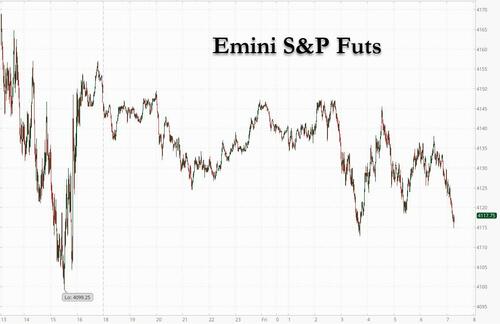
Stocks plunged on Thursday, completely erasing their gains from the prior session amid a broad-based selloff in risk assets. The S&P 500 Index sank 3.6% on Thursday, while the tech-heavy Nasdaq 100 Index plunged 5.1%, its biggest decline since September 2020. Still, some investors say that concerns may be overblown. “Looking back at just the past two days, it’s not really all that dramatic,” said Mattias Isakson, head of strategy and allocation at Swedbank, adding that indexes were roughly back to where they were compared to before the Fed press conference. “The overall market outlook hasn’t changed at all: interest rates and inflation worries will continue to create volatility in the short term,” Isakson said.
On Friday, shares of US-listed Chinese firms extended losses in premarket trading amid growing concerns about the country’s economic growth prospects and continued weakness in tech shares. Peloton shares dropped premarket after the company was said to be considering selling a stake of around 20%. Meanwhile, DoorDash jumped after earnings and Tesla gained after planning to boost car production at its Shanghai plant. Here are some more details on the biggest premarket movers today:
- Tesla (TSLA US) shares gain as much as 1.1% in U.S. premarket trading, leaving them set to bounce back following Thursday’s losses, after the electric-vehicle maker was said to be making plans to boost car production at its Shanghai plant as soon as mid-May.
- Shares of U.S.-listed Chinese firms extend losses in premarket trading amid growing concerns about the country’s economic growth prospects and continued weakness in tech shares. Alibaba (BABA US) -1.9%, Baidu (BIDU US) -2.4%, JD.com (JD US) -2%.
- Peloton (PTON US) shares fall as much as 1.7% in U.S. premarket trading after the maker of indoor exercise bikes was said to be considering selling a stake of around 20% as part of a turnaround.
- Cloudflare (NET US) shares drop 9.3% in U.S. premarket despite a boosted full-year revenue guidance; analysts say the outlook implies a significant deceleration for lead metrics. At least 3 analysts cut their price targets on the stock.
- Digital Brands Group (DBGI US) shares decline 50% in U.S. premarket trading after pricing an offering of 37.4m shares at $0.25 apiece, representing a discount of ~50% to Thursday’s close.
- DoorDash (DASH US) shares jump as much as 6.9% in U.S. premarket trading, with analysts positive on the food-delivery firm’s first-quarter update given tough pandemic comparisons and a difficult macroeconomic environment, though some trimmed price targets amid higher investments.
- Block Inc. (SQ US) shares rise 7% after 1Q results, with analysts upbeat on demand for the company’s Square and Cash App payment services as the fintech company displays resilience amid a challenging market.
- Live Nation (LYV US) shares gained 4% in postmarket trading. Its leading indicators like ticket sales, show counts and committed sponsorships remain robust, according to Guggenheim analyst Curry Baker.
- Opendoor (OPEN US) jumps as much as 16% in U.S. premarket trading after the real estate platform provider forecast revenue for the second quarter that beat the average analyst estimate.
- Zillow (ZG US) shares decline 6.7% in U.S. premarket trading after underwhelming guidance disappoints analysts, who believe that rising mortgage rates will cool the U.S. housing market. At least 3 analysts cut their price targets with one saying he doubts the real-estate technology firm’s ability to achieve its 2025 targets.
According to BofA, the global market selloff has further to run, as every asset class saw outflows in the week prior to the Federal Reserve’s meeting this week, with real estate posting its biggest outflow on record – $2.2 billion – and investors piling into safe havens like Treasuries although one wouldn’t know it judging by where yields are trading.
“The Fed is attempting to land a B52 bomber on a piece of string and most risk markets still have their fingers in their ears and their hands over their eyes,” said James Athey, a London-based investment director at abrdn. “Hope is not a strategy.”
The next key event for markets is Friday’s U.S. jobs report (full preview here), which will be closely watched for signs that rising wage costs are adding to the inflationary pressures rattling investors. Estimates by economists are looking for payrolls to expand by 380,000 in April, and the unemployment rate to fall to 3.5%, although whisper numbers are lower.
A print higher than 500,000 in non-farm payrolls will provoke U.S. dollar buying as equities and bonds sell-off, while less than 300,000 should see the reverse, says Jeffrey Halley at OANDA. “A sharp divergence, up or down, from the median forecast, should produce a very binary outcome,” he says. “It’s that sort of market.”
“Any upward pressure on the average hourly earnings could lead to another spike of U.S. yields and therefore add negative pressure on equities and especially tech stocks,” said Christophe Barraud, chief economist at Market Securities LLP in Paris.
In Europe, the Stoxx 600 Index followed the Wall Street rout and was set for its worst weekly drop in two months, with consumer, retail and travel and leisure among the biggest decliners. FTSE MIB posts the smallest decline. Retailers, consumer products and media are the worst performing sectors. Traders will be watching job data, while Cigna, Dish, NRG Energy and Under Armour are among companies reporting earnings. Here are the biggest European movers today:
- Grifols rose as much as 9.3%, to the highest since November, after the Spanish maker of pharmaceutical products derived from blood plasma gave a business update that Citi said supports its buy rating on the stock.
- Leonardo rose as much as 4.4% after reporting earnings. Deutsche Bank said 1Q numbers were solid, while Intesa Sanpaolo said the company delivered “a sound start” to 2022.
- S4 Capital shares gained as much as 9.9% after the digital advertising agency released delayed FY results that showed limited audit adjustments. Revenue was ahead of analyst expectations.
- SKF shares advanced, breaking a seven-session declining streak, after Danske Bank upgraded the shares to buy, saying they “could generate good return in the coming 3-12 months.”
- Krones shares surged as much as 11%, the most since October 2019, after the machinery company reported 1Q Ebitda that beat estimate, with analysts noting scope for upgrades.
- Ambu shares dropped as much as 17% after the Danish health care equipment firm cut its outlook. Handelsbanken says the new guidance may lead to a 30% drop in FY Ebit estimates.
- Adidas shares fell more than 6% after the German sportswear maker cut its margin outlook for the year. Analysts noted the impact of lockdowns in China. Peer Puma also fell.
- IAG fell as much as 12%, the most intraday since November. The British Airways parent posted a 1Q operating loss that Citi analysts said was worse than consensus and their own expectations.
- JCDecaux shares slumped as much as 12% after its 2Q organic revenue growth target of more than 15% fell short of analyst expectations amid lockdowns in China.
Earlier in the session, Asian stocks were on track for five straight days of losses, as traders questioned whether the Federal Reserve’s interest rate hike was enough to tackle inflation and Chinese leaders warned against doubting their Covid-Zero stance. The MSCI Asia Pacific Index declined by as much as 1.8%, poised for its longest losing streak since January and lowest closing level since July 2020. The broad-based selloff followed steep declines in U.S. shares overnight, with benchmarks in Australia, Taiwan and Vietnam each declining more than 1.7%.
“Volatility comes from doubts whether the 50 basis-point hike can be enough to curb inflation,” said Lee Han-Young, chief fund manager at DS Asset Management, a Seoul-based hedge fund. For market volatility to ease, CPI or other inflation-related data needs to peak or slow down, he said. “Before that, volatility seems inevitable.” Stock indexes in Hong Kong and mainland China were the worst performers in the region after the Politburo’s supreme Standing Committee reaffirmed its support for a lockdown-dependent approach on Thursday. Still, declines in Asia were less than the rout in U.S. shares, with generally smaller-sized market reactions to the Fed’s policy statement Wednesday. China’s economic slowdown and regulation of its tech industry are also playing on investors’ minds, with the Hang Seng Tech Index sliding amid a lack of concrete steps to support the industry. Overall, tech and financial stocks were among the biggest drags on the MSCI Asia Pacific Index. The measure is on track to fall about 2.6% this week, the largest weekly slide since mid-March. Bucking the regional trend, Japanese equities rose after a three-day holiday.
India’s benchmark stocks index registered its worst weekly decline in more than five months as growing concerns over higher borrowing costs to curb inflation dented risk sentiment. The S&P BSE Sensex declined 1.6% to 54,835.58 in Mumbai on Friday, taking its loss this week to 3.9%, the biggest five-day drop since the period ended Nov. 26. The NSE Nifty 50 Index slipped 1.6% to 16,411.25. HDFC Bank Ltd. fell 2.6% and was the biggest drag on the Sensex, which had 24 of the 30 member stocks trading lower. All but two of 19 sectoral sub-indexes compiled by BSE Ltd. fell, led by a gauge of realty companies. The Reserve Bank of India raised its policy rate by 40 basis points in an out-of-cycle move this week after keeping it at a record-low level of 4% for the past two years. “This suggests that the scales of growth versus inflation is tilted towards inflation and can be leading indicator of further rate hikes in FY23,” Shibani Kurian, head of equity research at Kotak Mahindra Asset Management Co. wrote in a note. She expects market participants to focus on earnings and commentary on demand and margins from companies. The U.S. Federal Reserve and Bank of England also raised rates to tackle rising inflation. In earnings, of the 24 Nifty 50 firms that have announced results so far, 17 either met or exceeded analysts’ estimates, while seven missed forecasts. Reliance Industries Ltd., the nation’s largest company, is scheduled to announce its results Friday.
In rates, Treasuries extended Thursday’s bear-steepening move, with yields cheaper by 2bp to 4bp across the curve, amid bigger losses for German bonds after ECB’s Villeroy said above-zero rates are “reasonable” by year-end, and that there are signs inflation expectations are less anchored. US 10-year yields around 3.09%, cheaper by ~3bp on the day with 2s10s steeper by ~2.5bp; front-end yields outperform, higher by ~2bp at around 2.72%. Dollar issuance slate empty so far and expected to be muted because of jobs report; four names priced $7.6b Thursday taking weekly total above $16b, shy of $20b-$25b expected range. Peripheral spreads eventually tighten slightly to core after 10y BTP/Bund briefly widening through 200bps
In FX, a gauge of the dollar’s strength was little changed as traders awaited a U.S. jobs report on Friday. Bloomberg Dollar Spot Index gained 0.2% as traders awaited the U.S. jobs report due on Friday. Ten-year Treasury yields rose 2 basis points to 3.05%. The yen underperformed most G-10 currencies as Japan’s markets reopened following a three-day holiday. Leveraged funds initiated long dollar-yen positions heading into U.S. payrolls data, according to an Asia-based FX trader
Long gamma exposure in the major currencies meets a fresh round of demand following the Bank of England’s policy decision, which is contributing to continued erratic moves in the options space into the U.S. report. Real money and hedge funds both net USD buyers, according to three Europe-based traders, with demand for USD calls in the likes of EUR, AUD and MXN.
In commodities, WTI trades within Thursday’s range, adding 1.6% to trade near $110. Spot gold rises roughly $5 to trade above $1,880/oz. Most base metals trade in the red. Bitcoin continues to slide, and was last trading below $36,000, after cracking to key support levels yesterday.
Looking at the day ahead now, the main highlight will be the aforementioned US jobs report for April. Other data releases include German industrial production and Italian retail sales for March. From central banks, we’ll hear from the ECB’s Villeroy, Nagel, Elderson and Rehn, the Fed’s Williams, Kashkari and Bostic, and the BoE’s Pill and Tenreyro.
Market Snapshot
- S&P 500 futures little changed at 4,140.00
- STOXX Europe 600 down 0.9% to 434.26
- MXAP down 1.6% to 164.46
- MXAPJ down 2.7% to 538.32
- Nikkei up 0.7% to 27,003.56
- Topix up 0.9% to 1,915.91
- Hang Seng Index down 3.8% to 20,001.96
- Shanghai Composite down 2.2% to 3,001.56
- Sensex down 1.4% to 54,941.03
- Australia S&P/ASX 200 down 2.2% to 7,205.64
- Kospi down 1.2% to 2,644.51
- German 10Y yield little changed at 1.07%
- Euro up 0.3% to $1.0570
- Brent Futures up 1.3% to $112.39/bbl
- Gold spot up 0.1% to $1,879.09
- U.S. Dollar Index down 0.31% to 103.43
Top Overnight News from Bloomberg
- European Central Bank Governing Council member Francois Villeroy de Galhau said interest rates may be raised back above zero this year if the euro-zone economy doesn’t suffer another setback.
- The European Union has proposed a revision to its Russia oil sanctions ban that would give Hungary and Slovakia an extra year, until the end of 2024, to comply, according to people familiar with the matter.
- China has ordered central government agencies and state-backed corporations to replace foreign- branded personal computers with domestic alternatives within two years, marking one of Beijing’s most aggressive efforts so far to eradicate key overseas technology from within its most sensitive organs.
- Germany is ready to support eastern European nations in their efforts to wean themselves off Russian energy to secure broader support for sanctions targeting the country’s oil and gas sector, Chancellor Olaf Scholz said Thursday
- The cost of living in Tokyo rose at the fastest pace in almost three decades in April, as the impact of soaring energy prices became clearer, an outcome that complicates the Bank of Japan’s messaging on inflation and the need for continued stimulus
- China’s top leaders warned against questioning Xi Jinping’s Covid Zero strategy, as pressure builds to relax virus curbs and protect the economic growth that has long been a source of Communist Party strength
- An escalating selloff in long-end Treasuries pushed yields to fresh multi-year highs Thursday, with the benchmark 10-year rate closing above 3% for the first time since 2018 as concern over inflation rattled the bond market
- Having plunged by the most on record in offshore trade last month, China’s yuan is now facing the threat of selling pressure from the nation’s companies
- The Federal Reserve will need to raise short-term interest rates to at least 3.5% to bring surging inflation under control, former Vice Chairman Richard Clarida said
- South Korea needs to act preemptively on risk factors while monitoring situations in the economy and markets, as there are concerns local financial and FX markets will react sensitively according to various factors, Vice Finance Minister Lee Eog-weon says
A more detailed look at global markets courtesy of Newsquawk
Asia-Pac stocks were mostly lower amid spillover selling from the sharp declines on Wall Street. ASX 200 was heavily pressured in which the losses in tech led the broad declines across all sectors. Nikkei 225 initially declined on return from the Golden Week holidays but then pared all its losses as currency weakness persisted with Japan also planning to introduce tax incentives, as well as ease border measures in June. Hang Seng and Shanghai Comp conformed to the downbeat mood with tech and property names dragging the Hong Kong benchmark lower, while China also remained steadfast in its “dynamic COVID clearance” policy.
Top Asian News
- Adidas Shares Drop Amid ‘Dialed-Down’ Outlook: Street Wrap
- JAL Sees Return to Profit as Japan Moves to Reopen Borders
- Food Prices Hold Near Record as Ukraine War Upends Global Trade
- Nine in 10 Central Banks Exploring Own Digital Money, BIS Says
European bourses are subdued across the board, Euro Stoxx 50 -1.1%, reacting to the late-doors pressure in Wall Street. Currently, US futures are modestly softer but relatively tentative overall going into the NFP release and subsequent Fed speak. US regulatory officials have arrived in China for “late-stage” audit deal talks, according to Reuters sources. China’s auto sales in April are estimated to have plunged 48.1% y-o-y to 1.17 million units, data from CAAM revealed. The recent Omicron outbreak has disrupted the auto sector, in particular in the Yangtze River Delta region, according to Global Times.
Top European News
- EU Plan to Ban Russian Oil Means Windfall for Hungarian Refiner
- BNP Paribas Offers Up to EU400m Non-Dilutive Convertible Bonds
- ECB’s Villeroy Says Above-Zero Rates ‘Reasonable’ This Year
- Sorrell Pledges Changes After S4’s ‘Embarassing’ Results Lag
In FX
- ECB officials ramp up hawkish rhetoric to boost Euro; EUR/USD makes round trip to high 1.0580 area from sub-1.0500.
- Pound continues to flounder as UK election results spell trouble for already under pressure PM Johnson and Tory Party, Cable under 1.2300 at one stage and EUR/GBP cross over 0.8550.
- Buck reverses all and more post-Fed losses pre-payrolls before Euro rebound knocks DXY back below 104.000, index down to new 103.340 low vs 104.070 peak.
- Aussie slumps despite hawkish RBA SOMP, Yen weak regardless of firmer than forecast Tokyo inflation data and return of Japanese markets from Golden Week; AUD/USD under 0.7100 and USD/JPY over 130.00.
- Loonie cushioned by strong crude prices ahead of Canadian LFS, USD/CAD within 1.2814-67 range and close to 1.29bln option expiries between 1.2835-40.
- Swedish Krona rangy after Riksbank minutes highlighting divergent views; EUR/SEK straddling 10.5000.
Fixed Income
- EZ debt downed by latest hawkish ECB guidance, Bunds below 152.00 and periphery underperforming.
- Gilts hold up better on the 118-00 handle awaiting BoE commentary after super Thursday.
- US Treasuries dragged down by Eurozone bonds to an extent, as 10 year T-note pivots 118-00 ahead of NFP.
Commodities
- WTI and Brent are bid in an exacerbation of APAC price action although, specific bullish-drivers have been somewhat sparse.
- Much of the focus has been on the potential EU Russian oil import embargo, particularly Hungary’s ongoing opposition and the EU’s attempts to appease them.
- Brazilian President Bolsonaro said a fresh hike in fuel prices by Petrobras could bankrupt Brazil and urged Petrobras not to increase fuel prices again, according to Reuters.
- PetroChina (0857 HK) says they have no plans to buy discounted Russian oil or gas, according to an executive.
- China is to sell 341k tonnes of imported soybeans from state reserve on May 13, according to the trade centre.
- Spot gold is bid but has failed to derive much traction above the 100- and 10-DMAs at USD 1883.08/oz and USD 1885.1/oz respectively.
Central Banks
- ECB’s Villeroy says too weak EUR would go against ECB inflation target; inflation is not only higher but broader; core inflation is firmly above target. Case for APP beyond June is not obvious. Adds, it is possible to raise rates into positive territory (i.e. above zero) by year-end.
- ECB’s Nagel says current inflation too high, confident it can get back to 2% target in the medium-term; adds, window to act is closing. Is optimistic re. a 2022 move. Does not buy the argument that policy should hold back because of the economy right now, via FAZ.
- ECB’s Holzmann said the ECB is planning to raise rates which they will discuss and probably do at the June meeting, while he added that rates will rise this year, by how much and when, will be discussed intensively in June, according to Reuters.
- ECB’s Vasle says appropriate timing to start ECB hikes is “before summer”; inflation is becoming broad-based, cannot claim that monetary policy cannot curb inflation.
- BoE’s Pill: says the BoE does not have a forex target or objective; when questioned on what would cause them to pause (re. hikes), says more evidence of factors becoming more consistent with target(s). If we don’t see this, will have to act further.
Market Snapshot
- 08:30: April Change in Nonfarm Payrolls, est. 380,000, prior 431,000
- April Change in Private Payrolls, est. 378,000, prior 426,000
- April Change in Manufact. Payrolls, est. 35,000, prior 38,000
- April Unemployment Rate, est. 3.5%, prior 3.6%
- April Underemployment Rate, prior 6.9%
- April Labor Force Participation Rate, est. 62.5%, prior 62.4%
- April Average Hourly Earnings YoY, est. 5.5%, prior 5.6%
- April Average Weekly Hours All Emplo, est. 34.7, prior 34.6
- April Average Hourly Earnings MoM, est. 0.4%, prior 0.4%
- 15:00: March Consumer Credit, est. $25b, prior $41.8b
Fed Speakers
- 09:15: Fed’s Williams Gives Opening Remarks
- 11:00: Fed’s Kashkari Takes Part in Moderated Discussion
- 15:00: Fed’s Bostic Gives Commencement Address at Georgia Tech
- 19:15: Fed’s Bullard and Waller Speak on Hoover Institute Panel
- 20:00: Fed’s Daly Gives Commencement Speech
DB’s Jim Reid concludes the overnight wrap
What’s dangerous about yesterday’s huge market slump is that there must be an element of doubting the ability of there to be an effective “Fed Put” in this cycle following a 30-40 year period where the central bank has almost always been able to come to the market’s rescue. As we know, Wednesday saw a strong post-FOMC rally (S&P 500 +2.99%) on a belief that the Fed would be relatively measured in their tightening cycle after Chair Powell pushed back against 75bp hikes. However in a remarkable turnaround yesterday (S&P 500 -3.56%) the only conclusion you can draw is that the market quickly realised that the Fed really aren’t going to be able to control this cycle very easily.
As you know our view is that the Fed won’t be able to achieve a soft landing and that a recession is coming. This was something we dwelt on in our recent “What’s in the Tails?” piece (link here), where we expressed surprise that our call for a US recession in late-2023 was the outlier rather than the consensus given how far inflation is from target and the tightness of the US labour market right now (more today on this in the payrolls report).
I can’t help but think that a great deal of the reaction yesterday was the appreciation that whilst the Fed can make soothing pronouncements, they are starting from an extraordinary difficult starting point, and with limited flexibility to respond to market or economy concerns whilst they fight inflation.
The Bank of England couldn’t have helped either, as they became the first major central bank to forecast a contraction in 2023 alongside double-digit inflation later this year.
In terms of the moves themselves, US Treasury yields soared to fresh highs for this cycle at the long end, with those on 10yr Treasuries up +10.2bps at 3.04%, after a volatile day that saw 10yr yields increase as much as +17.2bps to 3.11% intra-day, meaning the 10yr range since the FOMC has been +21bps wide. Yesterday’s increase was driven entirely by real yields, which snapped back up by +12.2bps to 0.18%, thus closing at their highest levels since the Covid-related tumult in March 2020. Real yields were also as much as +17.2bps higher intraday, showing they were a large component of yesterday’s volatility. The rise in yields came as investors retraced some of their expectations from the previous day about a shallower pace of monetary tightening, raising the expected rate at the Fed’s December meeting by +5.0bps. And there was further evidence that the Fed’s tightening cycle is already having an effect on the real economy, with Freddie Mac reporting that the average rate for a 30-year mortgage had risen to 5.27%, which is the highest its been since 2009. It also marks a +231bp increase over the last year, which is the largest annual increase in mortgage rates since 1982. Those trends have continued this morning, with yields on 10yr USTs up +1.9bps to 3.06%, and the policy rate priced for December’s meeting up a further +1.3bps.
With yields bouncing higher, US equities were hammered once again with the more interest-sensitive tech stocks leading the way. As mentioned at the top, the S&P 500 fell back by -3.56%, which would be more newsworthy were it not for the fact that Friday’s -3.63% decline was even larger! Tech and mega-cap stocks really bore the brunt of the sell-off, as the NASDAQ slumped -4.99%, the largest since June 2020, and the FANG+ index fell -6.43%, the largest since September 2020, with all those indices ending a run of 3 consecutive advances. The sharp turnaround sent the VIX +6.07pts higher, and back above 30 at 31.49. It was a somewhat better picture in Europe, but that reflected the fact they hadn’t participated in the massive US rally after the Fed. However the major indices lost ground continuously through the day, with the STOXX 600 erasing an initial gain of +1.84% immediately after the open to end the day -0.70% lower.
Yesterday’s volatility came alongside a fresh round of central bank news, with the Bank of England continuing its recent series of rate hikes. In terms of the main headlines, they hiked by 25bps as expected to take Bank Rate up to 1%, and 3 of the 9 members on the Committee were even in favour of a larger 50bps move. Nevertheless, the decision was interpreted in a very dovish light, as two members did not find it appropriate to provide guidance for more rate hikes going forward, so potentially a three-way split on the committee. Adding to the dovish interpretation, the growth forecasts produced by the BoE were significantly downgraded, and now see an annual economic contraction occurring in 2023. Furthermore, they upgraded their inflation forecasts once again, seeing CPI rising further over the rest of 2022, and averaging “slightly over 10% at its peak” in Q4. For more info on the BoE, see our economist’s full reaction note (link here).
The more downbeat news on the economy led investors to reappraise the likely path of future hikes from the BoE, and overnight index swaps took out -17bps worth of tightening by the December meeting in response. In turn, sterling was the worst-performing G10 currency yesterday, with a -2.13% move against the US Dollar, which came as investors took stock of the potential for a more gradual tightening, as well as the prospect of a UK recession. The developments also meant that gilts outperformed their counterparts elsewhere in Europe, with the 10yr yield coming down -0.3bps on the day, a big contrast to those on bunds (+7.3bps), OATs (+7.2bps) and BTPs (+8.3bps) which all moved higher. These losses were witnessed over on the credit side as well, where the iTraxx Crossover index moved up +19.3bps to 453bps, the highest its been since May 2020.
Those moves higher in Euro Area yields came as the drum beat for an ECB rate hike as soon as July continued, with Bank of Finland’s Governor Rehn endorsing a hike in July. This is a world away from the situation just after Russia’s invasion of Ukraine, when there was serious scepticism among many that the ECB would be able to hike at all this year given the growth shock. But the inflation developments have outweighed that, and overnight index swaps are still pricing in 89bps worth of hikes this year, enough to take the current -0.5% deposit rate firmly into positive territory. Remember DB is forecasting +100bps of hikes before year end.
Overnight in Asia, equities have similarly begun the day deep in negative territory, tracking those sharp overnight losses on Wall Street. Across the region, the Hang Seng (-3.67%) is the largest underperformer with tech firms among the worst hit. In mainland China, the Shanghai Composite (-2.31%) and CSI 300 (-2.59%) have also seen a large slide as COVID-19 lockdowns continue to darken the economic outlook and weigh on investor sentiment. There’ve been further signs they’ll be continuing their zero Covid strategy overnight, with state broadcaster CCTV reporting that the Politburo’s seven-member Standing Committee reaffirmed their support for the approach. The only place not seeing large slides overnight are Japanese markets, where the Nikkei is up +0.92%, but that reflects the fact they’ve come back to trade today after 3 days of holidays. Looking forward, US stock futures are pointing to a stabilization today, with contracts on the S&P 500 (-0.02%) and NASDAQ 100 (-0.02%) marginally lower.
From the perspective of the major central banks, another negative development over the last 24 hours has been the continued rise in oil prices, with Brent Crude up another +0.69% yesterday to reach $110.90/bbl. The move was driven by the news that the US Energy Department would begin the process of replenishing its oil reserves, with a process to buy 60m barrels in the autumn. That said, prices pared back their gains in the European afternoon as the more negative risk-off move took hold, with prices declining from an intraday high of $114/bbl at one point. This morning in Asian trading hours, Brent crude (+0.50%) is extending its gains again, now at $111.46/bbl.
Looking forward now, the main highlight today will likely be the US jobs report for April, which along with next Wednesday’s CPI reading will help frame the policy debate over the 6 weeks ahead of the next FOMC meeting in mid-June. In terms of what to expect, our economists think that nonfarm payrolls will have risen by +465k, which in turn will lower the unemployment rate by a tenth to 3.5%. That would be a significant milestone, since 3.5% was the pre-pandemic low in the unemployment rate.
On the data side, the US weekly initial jobless claims came in at 200k in the week through April 30 (vs. 180k expected). Elsewhere, German factory orders fell by a larger-than-expected -4.7% in March (vs. -1.1% expected).
To the day ahead now, and the main highlight will be the aforementioned US jobs report for April. Other data releases include German industrial production and Italian retail sales for March. From central banks, we’ll hear from the ECB’s Villeroy, Nagel, Elderson and Rehn, the Fed’s Williams, Kashkari and Bostic, and the BoE’s Pill and Tenreyro.
3. ASIAN AFFAIRS
i)FRIDAY MORNING// THURSDAY NIGHT
SHANGHAI CLOSED DOWN 66.20 PTS OR 2.16% //Hang Sang CLOSED DOWN 791.44 OR 3.81% /The Nikkei closed UP 185.03 OF .63% //Australia’s all ordinaires CLOSED DOWN 2.25% /Chinese yuan (ONSHORE) closed DOWN 6710 /Oil UP TO 110.24 dollars per barrel for WTI and UP TO 113/13 for Brent. Stocks in Europe OPENED ALL RED // ONSHORE YUAN CLOSED DOWN AGAINST THE DOLLAR AT 6.6710 OFFSHORE YUAN CLOSED DOWN ON THE DOLLAR AT 6.67985: /ONSHORE YUAN TRADING BELOW LEVEL OF OFFSHORE YUAN/ONSHORE YUAN TRADING WEAKER AGAINST US DOLLAR/OFFSHORE WEAKER//
3 a./NORTH KOREA/ SOUTH KOREA
///NORTH KOREA
END
3B JAPAN
3c CHINA
CHINA//SHANGHAI/LOCKDOWNS/USA
CCP Orders Government Agencies, State-Controlled Firms To Dump Foreign PCs & Software
FRIDAY, MAY 06, 2022 – 11:40 AM
Although it has been overshadowed by the conflict in Ukraine, the rift between the US and China has remained during the Biden Administration (as the White House has continued to supply arms to Taiwan in defiance of Beijing’s demands that no foreign entities interfere).

So, in the latest demonstration of distrust, Beijing has ordered all government agencies and state-controlled corporations (which is to say, most companies in China) to dump all foreign-branded PCs, and replace them with Chinese-made products. What’s more, the new PCs must run on operating systems developed domestically, according to the order.
Here’s more from Bloomberg:
Staff were asked after the week-long May break to turn in foreign PCs for local alternatives that run on operating software developed domestically, people familiar with the plan said. The exercise, which was mandated by central government authorities, is likely to eventually replace at least 50 million PCs on a central-government level alone, they said, asking to remain anonymous discussing a sensitive matter.
The decision advances China’s decade-long campaign to replace imported technology with local alternatives, a sweeping effort to reduce its dependence on geopolitical rivals such as the U.S. for everything from semiconductors to servers and phones. It’s likely to directly affect sales by HP Inc. and Dell Technologies Inc., the country’s biggest PC brands after local champion Lenovo Group Ltd.
Chinese laptop and software stocks rallied on the news. Lenovo (now owned by a Chinese entity after being bought years ago from IBM) erased losses to climb as much as 5% on Friday in Hong Kong, while software developer Kingsoft gained 3.3% on the news, erasing earlier losses.
On mainland Chinese exchanges, server maker Inspur gained 6% while peer Dawning Information Industry jumped more than 4%. Inspur Software, an affiliate of the Inspur group, and China National Software & Service, both soared their daily 10% limits.
This policy of replacing foreign software and hardware with domestic alternatives is nothing new for the Chinese, but the effort intensified after the Trump Administration hamstrung Huawei with a raft of sanctions and the Commerce Department ‘blacklist’.
But the initiative accelerated after 2021 when the Chinese central government quietly empowered a government-backed organization to vet and approve local suppliers, blocking foreign vendors from sensitive high-tech industries from the cloud to semiconductors.
Fortunately for the Chinese, many of the world’s biggest laptop and server makers today include domestic firms, including Lenovo, Huawei and Inspur, while local developers such as Kingsoft and Standard Software have made rapid strides in office software against the likes of Microsoft and Adobe
END
4/EUROPEAN AFFAIRS//UK AFFAIRS/EU
SWEDEN/EU/NATO/USA
Brilliant!! Russia will be thoroughly annoyed with this: USA gives Sweden its security assurances if it submits to its NATO application
(Duschamps/EpochTimes/GATA)
US Gives Sweden Security Assurances If It Submits NATO Application
FRIDAY, MAY 06, 2022 – 03:30 AM
Authored by Lorenz Duschamps via The Epoch Times,
The U.S. government on Wednesday reaffirmed to Sweden its commitment to NATO’s “open-door policy” and will support the Nordic country during the period of a potential NATO application.

Swedish Foreign Minister Ann Linde met with U.S. Secretary of State Antony J. Blinken in Washington on May 4 and discussed NATO’s commitment to welcoming new members and assuring European security, among other issues.
“Blinken underscored the importance of the Transatlantic relationship to European security and reaffirmed our commitment to NATO’s Open Door policy,” U.S. State Department spokesman Ned Price said in a press release.
Price said Blinken also thanked Sweden for its “extensive humanitarian and security assistance” to Ukraine and discussed potential ways to provide more support to the country in conflict. They further discussed bilateral cooperation on international issues that include strengthening food security, advancing democracy, and support for the ongoing truce in Yemen.
The release declined to say what assurances Linde had received from Blinken. The move comes on the same day British Defense Secretary Ben Wallace said the UK would always help Finland if it were attacked by Russia, whether or not the country was a member of NATO.

Defense Secretary Ben Wallace walks along Downing Street as he heads to the weekly Cabinet meeting at the Foreign Office in London, England, on Nov. 10, 2020. (Leon Neal/Getty Images)
“Naturally, I’m not going to go into any details, but I feel very sure that now we have an American assurance,” Linde told Swedish TV from Washington after meeting Blinken, Reuters reported. “However, not concrete security guarantees, those you can only get if you are a full member of NATO,” she added.
Finland and Sweden are partners of the NATO military alliance, but not full members. Following Russia’s attack on Ukraine, both countries reviewed long-held beliefs that military neutrality is the best means of ensuring national security. They are expected to make a decision about whether to apply to join NATO this month.
Both countries are concerned they would be vulnerable during an application process, which could take up to a year to be approved by all NATO members.
Linde said the guarantees would mean that the United States wouldn’t allow Russia to use any direct kind of negative activities against Sweden. Such actions would trigger a response from their U.S. counterpart.
Once a country is a full member of NATO, it will benefit from its collective defense clause, which obliges all 30 member countries to come to the aid of any ally that comes under attack.
Russia, for its part, has previously warned Sweden and Finland against joining NATO, with officials saying it wouldn’t contribute to stability in Europe. Moscow said it would respond to such a move with retaliatory measures that would cause “military and political consequences” for Helsinki and Stockholm.
Sweden’s defense minister said last month that an application could trigger a number of responses from Russia, including cyberattacks and hybrid measures—such as propaganda campaigns—to undermine Sweden’s security.
In addition, Moscow has also warned it could use nuclear weapons in the European exclave of Kaliningrad if Sweden and Finland become NATO members.
end
BULGARIA/CZECH REPUBLIC/RUSSIA/EU
Bulgaria and the Czech Republic which both buy huge amounts oil oi from Russia is pushing for exemptions so they can continue purchasing from Putin
(zerohedge)
Bulgaria & Czech Republic Join Growing List Pushing For Exemptions On Russian Oil Embargo
FRIDAY, MAY 06, 2022 – 04:15 AM
It’s clear at this point that to push through its Russian oil embargo, the European Commission will have to provide exemptions to Hungary and Slovakia. But the hoped-for effectiveness Brussels wants achieve by what would be a necessary generally unified EU front appears to be on shakier and shakier grounds, given the growing number of central and eastern European countries demanding to still be allowed to buy Russian oil under the “ban”.
After Hungary, Slovakia and the Czech Republic, Bulgaria is now the latest to jump on the exemptions bandwagon. Bulgarian Deputy Prime Minister Assen Vassilev first announced on Wednesday his country’s intent to do so, as he stressed concern over rising fuel prices for the population.

“Bulgaria, technologically, can do without Russian oil crude, but that would push up fuel prices significantly. So, if the European Commission considers exemptions, we would like to take advantage of such exemptions,” Vassilev was quoted as telling a regional media outlet.
Certainly the small but growing number of countries – with Orbán’s Hungary being the first and most vocal – will likely be joined by more given the logic echoed in the Bulgarian official’s above explanation.
It suggests a cascading effect on the horizon should the European Commission open the exemptions door – and then more will “take advantage” rather than making the ‘sacrifice’ of soaring fuel costs, the difficulty of tapping alternate supplies, and the likely ensuing political blowback domestically… all to punish Russia which in the end may come out better than individual EU countries, given the potential India-China (and others) export lifeline.
The other scenario, based on the latest words out of the Czech Republic, is that the floated six month embargo initiation timeline currently being discussed – or at least by year’s end – would keep getting extended to allow countries scrambling to stave off ill effects of supply drop to be “ready”…
The Czech Republic is one of the countries that have called for a two-to-three-year transition period from the EU’s plan to ban Russian oil imports. Within this timeframe, the government hopes to enlarge alternate delivery systems such as the TAL pipeline running from Italy. But to do this, Czechia first needs to secure approval from current TAL users – Germany, Italy and Austria.
Czech prime minister Petr Fiala explained of his country’s desire for an exemption, “We are ready to support this decision under the condition that the Czech Republic will be able to delay its implementation until the capacity of oil pipelines leading into the Czech Republic is increased.”
We doubt Putin’s wartime strategy-making will be much impacted if there’s a two-to-three-year transition period before an oil ban takes effect…
Places like Bulgaria have have already seen severe momentary fuel shortages this year, which has quickly translated in to long queues and columns of cars at gas stations, driving frustration among the population as recently as the month of March. It’s unlikely the average person in Europe will stomach for too long soaring prices at the pump for the sake of ‘punishing Russia’.
end
HUNGARY/EU/RUSSIAN OIL BAN
(ZEROHEDGE)
Russian Oil Ban Will Be Like “Dropping Atomic Bomb On Hungary’s Economy”: Orban
FRIDAY, MAY 06, 2022 – 09:27 AM
Hungary’s Prime Minister Viktor Orbán has again loudly expressed his country’s firm rejection of the proposed EU ban on the import of all Russia oil currently being mulled by the European Commission, saying that it would be like an atomic bomb was dropped on the economy.
He said bluntly during an interview with a public national broadcaster that it would be like “dropping a nuclear bomb on the Hungarian economy”.

“We cannot accept a proposal that ignores this,” Orbán again stressed, while also saying his government would remain “happy to negotiate” a compromise that would take into serious account Hungary’s demands.
The trio of Hungary, Slovakia and the Czech Republic now constitute a significant obstacle to a Russian oil ban as the question of the European Commission granting exemptions is front and center. Bulgaria has become the latest country to propose that exemptions be given.
Some countries are also asking for more time to find alternative supplies, possibly even three to five years before a ban takes effect – despite it being possible that the war could long be over by that point.
Orbán too, said that Hungary “would need four to five years to revamp its energy system and become independent from Russian oil,” as summarized of his latest interview comments. Writes Euronews, “He noted that, while other EU states can bring additional crude barrels through their ports, Hungary, a landlocked country, lacks that alternative path.”
Thus it’s clear at this point that a growing list of countries, led by the example of the outspoken Hungarian leader, are less than eager to take up Ursula von der Leyen’s call to make ‘sacrifices’ for the sake of punishing Russia and Putin over the Ukraine invasion:
The costs to the EU would be high, von der Leyen said, but added it was a step worth taking to punish Russia for its invasion of Ukraine.
“Let us be clear: it will not be easy. Some member states are strongly dependent on Russian oil. But we simply have to work on it,” the she told the European Parliament.
Earlier in the week, Czech prime minister Petr Fiala explained of his country’s desire for an exemption: “We are ready to support this decision under the condition that the Czech Republic will be able to delay its implementation until the capacity of oil pipelines leading into the Czech Republic is increased.”
However, we doubt Putin’s wartime strategy-making will be much impacted if there’s a two-to-three-year or even five year transition period before an oil ban takes effect, which is precisely what the Czech Republic and others, with Hungary at the helm, are now proposing.
end
EU ‘Almost There’ On Reaching Russian Oil Ban As It Negotiates Giving Hungary More Time
FRIDAY, MAY 06, 2022 – 12:20 PM
EU Foreign Policy chief Josep Borrell has confirmed on Friday that the European Commission is considering agreeing to Hungary and other countries’ request for more time and money to find alternatives to Russian oil amid the mulled embargo, according to FT. He also claimed EU negotiators are ‘almost there’ on an agreement for a new anti-Russia sanctions package.
This after the unbending words from Hungarian PM Viktor Orbán saying “We cannot accept a proposal that ignores this” in a state media interview. He said Hungary would be “happy to negotiate” a compromise that would take into serious account its demands.
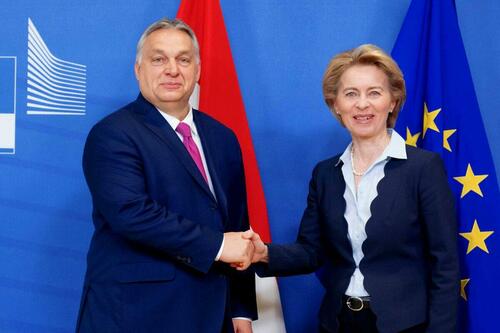
Inter-EU talks have reportedly become “stuck” after Hungary’s objections, which has also lately included the Czech Republic, Slovakia, and Bulgaria expressing a desire for exemptions. It’s now being reported that EU ambassadors will take at least through the weekend to achieve a deal.
European Commission President Ursula von der Leyen is vowing to find a path forward within “days” – as she told an audience Friday…
…that finding unity on oil sanctions isn’t easy and may take “some days,” but added she is confident that a deal will be reached. EU diplomats are meeting Friday to discuss the revised proposals and negotiations could stretch into the weekend, one person said.
According to the latest from Bloomberg, “The European Union has proposed a revision to its Russia oil sanctions ban that would give Hungary and Slovakia an extra year, until the end of 2024, to comply, according to people familiar with the matter.”
However, Orbán on Friday said that Hungary “would need four to five years to revamp its energy system and become independent from Russian oil,” as summarized of his latest interview comments. Writes Euronews, “He noted that, while other EU states can bring additional crude barrels through their ports, Hungary, a landlocked country, lacks that alternative path.”
“The Czech Republic would also be granted an exemption until June 2024, the people said. All other member states would phase out their imports by the end of this year as originally proposed, with imports of crude halting in six months and refined petroleum products in eight months,” Bloomberg reports.
However, this is also unlikely not to satisfy Czech prime minister Petr Fiala, who explained earlier of his country’s desire for an exemption: “We are ready to support this decision under the condition that the Czech Republic will be able to delay its implementation until the capacity of oil pipelines leading into the Czech Republic is increased.” The timeline for this being widely floated by the objecting countries is three to five years.
5. RUSSIAN AND MIDDLE EASTERN AFFAIRS
RUSSIA//USA
Yesterday was USA intelligence used to take out quite a few generals. Now we learn that USA intelligence assisted in the sinking of the Russian flagship vessel, the Moskva
(zerohedge)
US Intel Assisted In Sinking Russian Flagship Vessel: Officials Claim Bombshell Escalation
THURSDAY, MAY 05, 2022 – 07:46 PM
Less than 24 hours after The New York Times issued a provocative report citing unnamed US officials who are celebrating that American intelligence-sharing with Ukraine’s military has helped take out multiple Russian generals since the Feb.24 invasion, NBC News is out with yet another bombshell claim sourced to the deep state US intel officials.
Amid what seems escalation after escalation, and new revelations of Washington’s deepening and perhaps increasingly direct role in fighting Russia in Ukraine, NBC brings us this doozy… “Intelligence shared by the U.S. helped Ukraine sink the Russian cruiser Moskva, U.S. officials told NBC News, confirming an American role in perhaps the most embarrassing blow to Vladimir Putin’s troubled invasion of Ukraine.”

As a reminder of just how hugely significant the claim is – and just how dangerous in terms of representing a massive escalation – the Moskva was considered the flagship of Russia’s Black Sea Fleet, had 510 crewmen on board before Neptune anti-cruise ship missiles scored a direct hit in mid-April, and was the most embarrassing single blow to President Putin’s war effort of the whole conflict thus far.’
“The attack happened after Ukrainian forces asked the Americans about a ship sailing in the Black Sea south of Odesa, U.S. officials told NBC News,” the report continues. “The U.S. identified it as the Moskva, officials said, and helped confirm its location, after which the Ukrainians targeted the ship.” This comes after the NY Times revealed in a report the night prior that much of the intel-sharing is focused on Russian troop and equipment movements.
According to further details based on anonymous US senior officials:
The U.S. did not know in advance that Ukraine was going to target the Moskva, officials said, and was not involved in the decision to strike. Maritime intelligence is shared with Ukraine to help it defend against attack from Russian ships, officials added.
The U.S. role in the sinking has not been previously reported.
Biden admin officials in the days after the Moskva sinking had been relatively silent, possibly suggesting that they knew more about the details than what their quiet public stance let on.
The April 15 event had initially also been met with lack of answers from Moscow as it attempted to deal with the crisis of its flagship missile cruiser sinking to the bottom of the Black Sea after it was hit off Odessa, and as it later said all the crew were evacuated. However some Ukrainian and Western officials said the ship suffered casualties.
It goes without saying that this fresh NBC report will be viewed by Moscow as an outrageous acknowledged escalation by Washington, though so far Russian leadership’s public response has been rather muted…
The Kremlin had previously warned it would hold external countries supplying arms and other forms of assistance “responsible” – and that “decision-making” centers including Kiev would come under increased attack. Meanwhile, cruise missile strikes even as far west as Lviv do appear to be expanding this week.
Indeed it seems that these intentional “leaks” to the media, likely as part of a deliberate strategy of seeking to intimidate Russia in hopes it will more quickly back off its military operations, will instead only serve to ratchet things further as broader great power tensions hit boiling point.
RUSSIA /USA
USA denies helping Ukraine sink the Moskva
(zerohedge)
Pentagon Denies Helping Ukraine Sink Moskva After Series Of Intel-Sharing Reports
FRIDAY, MAY 06, 2022 – 01:00 PM
The Pentagon on Friday denied that it provided Ukrainian forces with intelligence that led to the sinking of the Russian Black Sea warship Moskva, which was struck reportedly by Ukrainian Neptune anti-ship missiles on April 14 and marked the most disastrous single Russian loss to date.
“We did not provide Ukraine with specific targeting information for the Moskva,” Pentagon spokesman John Kirby said in a statement, following the night prior NBC cited US officials who said that intelligence-sharing led to the missile cruiser’s sinking.

He added: “We were not involved in the Ukrainians’ decision to strike the ship or in the operation they carried out,” and that, “We had no prior knowledge of Ukraine’s intent to target the ship. The Ukrainians have their own intelligence capabilities to track and target Russian naval vessels, as they did in this case.”
He was responding to questions generated by a number of major reports in The New York Times and NBC News over the last couple days. These have included anonymous senior US officials telling the press that robust US intelligence sharing efforts with the Ukrainians have led to significant battlefield losses for the Russians.
First, a Wednesday NYT report claimed that intelligence sharing with the Ukrainians had helped take out some of the estimated 12 Russian generals that have died on the front lines since the Feb.24 invasion.
The New York Times reported that “The United States has focused on providing the location and other details about the Russian military’s mobile headquarters, which relocate frequently.” Additionally, “Ukrainian officials have combined that geographic information with their own intelligence — including intercepted communications that alert the Ukrainian military to the presence of senior Russian officers — to conduct artillery strikes and other attacks that have killed Russian officers.”
Following this, on Thursday night an even more significant bombshell was issued by NBC, wherein defense or intelligence officials were quoted as saying the operation which led to the sinking of the Russian Black Sea flagship Moskva had assistance from US intelligence.
“The attack happened after Ukrainian forces asked the Americans about a ship sailing in the Black Sea south of Odesa, U.S. officials told NBC News,” the report indicated. “The U.S. identified it as the Moskva, officials said, and helped confirm its location, after which the Ukrainians targeted the ship.”
Either Kirby is parsing his words very carefully in a ‘plausible deniability’ type way (for example: hinging on precise definition of “specific targeting information” etc), or it could be that it wasn’t US military intelligence per se that was involved… as in the Central Intelligence Agency was possibly behind it, making it not under the purview of the Department of Defense/Pentagon.
TURKEY
The state of affairs inside Turkey now:
(zerohedge)
It Could Be Worse… You Could Be Living In Turkey
FRIDAY, MAY 06, 2022 – 07:00 AM
Remember: just when you think all hope is lost and it can’t possibly get any worse… you could be living in Turkey.
Earlier today we learned that headline inflation in the biggest of all basket case countries, the cartoon republic of Turkey, rose from 61.1% Y/Y in March to 70.0% Y/Y in April, the highest print in 20 years, and above consensus expectation of “only” 68% y/y.
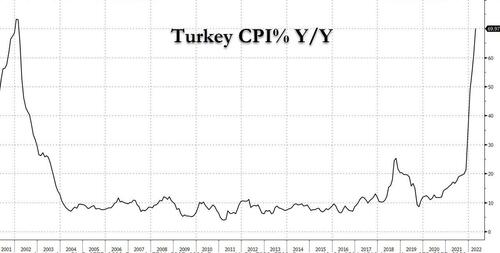
Not exactly shocking, but core inflation also increased, from 48.4%Y/Y to 52.4%Y/Y, slightly below the consensus expectation of 53% Y/Y and 52.9% Y/Y, respectively.
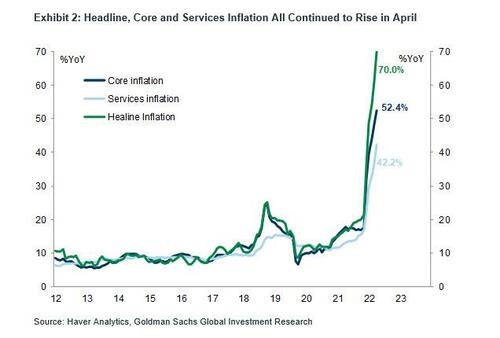
While the rise in headline inflation was broad based with all categories registering increases, the degree of the acceleration was disproportionately driven by an outsized contribution from the food category. In contrast to the previous two months, the housing and utilities category had the second largest contribution in April, followed closely by the transport category reflecting the pass-through from the uptrend in global energy prices.
Sequential headline inflation also strengthened (increased 124.6%mom annualized., compared to 100.9%mom annl. in March) but remained lower compared to December and January, as the sharp Lira sell-off in 2021Q4 led to a more front-loaded and faster pass-through to prices in these two months. Nevertheless, the underlying pricing pressures remain highly elevated and inflation expectations continue to climb higher.
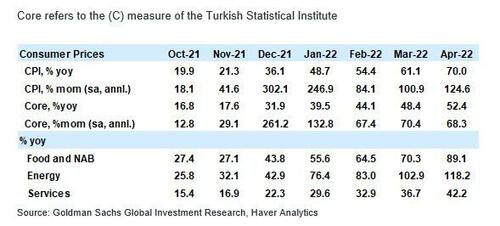
More details:
- All categories registered increases and there was a broad-based rise in inflation in April. Food inflation increased sharply, from 70.3%yoy to 89.1%yoy, contributing 4.8pp to the overall increase and becoming the leading driver of the rise in inflation. Rising food prices stand in contrast to the TCMB’s expectation that vegetable and fruit prices will fall with warmer weather.
- Housing, water, electricity, gas and other fuels inflation rose from 51.4%yoy to 61.1%yoy contributing 1.4pp to the overall rise in inflation, partially due to a 29% hike in water supply tariffs in Istanbul, which hosts around 19% of Turkey’s population, and increases in gas prices. The housing and utility category registered its highest increase in January 2022 to 48.4%yoy from 28.6%yoy in December on the back of significant hikes to electricity and gas prices, followed by marginal increases in March and February.
- Transport inflation increased from 99.1%yoy to 105.9%yoy on the back of high fuel inflation and contributed 1.1pp to the overall increase. Furniture and household equipment inflation rose from 69.3%yoy to 77.6%, adding another 0.7pp to the increase in the headline number. Restaurant and hotel inflation increased from 60.4%yoy to 69.3%, contributing 0.6pp to the increase in headline inflation.
- There was a pickup in the pace of sequential inflation (from 100.9%mom annl. in March to 124.6%mom in April). Although sequential inflation is lower than it was in December and January, it is still running at a very elevated level. The median change across the components of the CPI basket and the pricing component of the PMI reveal high inflationary pressures.

The distribution of price changes around the median continues to have a right fat tail, suggesting ongoing large price increases. Services inflation rose from 36.7%yoy to 42.2%yoy, also pointing to the fact that underlying inflation is very high.
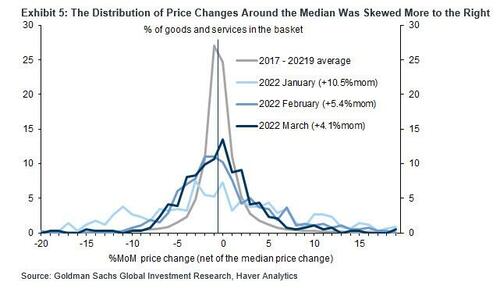
Going forward, inflation will rise even more and according to Goldman, will stay above 70%yoy until November and only fall to 60%yoy at the end of the year with the help of base effects. The central bank’s inflation projections have consistently been lower (currently at 42.8%yoy for end-2022) and the Bank continues to focus more on extending cheap credit to priority sectors while attributing rising inflation predominantly to the war in Ukraine. There is therefore significant upside risks to inflation from loose monetary policy and the utilization of heterodox measures that are not sufficient to fight inflation. The rising commodity prices add to the risks.
end
6// GLOBAL COVID ISSUES/VACCINE MANDATE/
FDA limits J andJ covid 19 vaccines over blood clot risk
FDA Limits J&J’s COVID-19 Vaccine Over Blood Clot Risk
FRIDAY, MAY 06, 2022 – 08:45 AM
The Food and Drug Administration (FDA) on Thursday strictly limited who can receive Johnson & Johnson’s Covid-19 vaccine due to a rare but serious risk of blood clots.
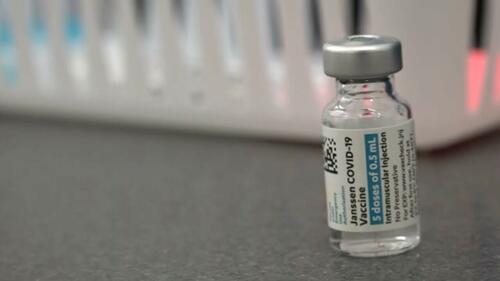
After ‘taking another look at the data’ on the risks of life-threatening blood clots, the FDA’s head of vaccines, Dr. Peter Marks, said that only adults who cannot receive a different vaccine, or specifically request J&J’s shot can get one, according to the Associated Press.
“If there’s an alternative that appears to be equally effective in preventing severe outcomes from COVID-19, we’d rather see people opting for that,” said Marks. “But we’ve been careful to say that– compared to no vaccine– this is still a better option.”
The problem occurs in the first two weeks after vaccination, he added: “So if you had the vaccine six months ago you can sleep soundly tonight knowing this isn’t an issue.”
The vaccine was initially considered an important tool in fighting the pandemic because it required only one shot. But the single-dose option proved less effective than two doses of the Pfizer and Moderna vaccines. -AP
The clotting is more common in women under 50, who suffered a fatality rate of roughly 1 per million shots, according to Marks. Overall, federal scientists flagged 60 cases of the side effect, including nine that were fatal.
According to Marks, the FDA ‘spent extra time’ evaluating whether the J&J vaccine clotting was connected to a separate issue such as birth control, which can raise the risk of clotting.
To nobody’s surprise, Twitter labeled the headline “Misleading” when tweeted by @Breaking911, however AP’s same exact headline wasn’t flagged.
Perhaps the Ministry of Disinformation can provide us with ‘context.’
END
Dr Paul Alexander….
mRNA injection DOES cause blood clots, just ask Hoffe; The HILL’s article today is misleading, it says the mRNA has no clot risks, thats a huge lie and the science/data shows it causes clot risks.Dr. Paul AlexanderMay 6THE HILLFraudulent statement that is a pure lie:“Importantly, the Pfizer and Moderna vaccines do not carry the same risks of blood clots, given they use a different technology than the Johnson & Johnson vaccines.”versusDr. Charles Hoffe who actually saw patients and report on the clots post mRNA vaccine:When Covid vaccine is injected into your arm muscle the original design intended that 100% of its contents remain there. However it now appears that only 25% of it stays in the arm muscle with the remaining 75% collected by your lymphatic system which is then fed into your circulation. A single dose of Moderna vaccine delivers 40 trillion tiny packages of these RNA molecules with 22.5 trillion of these collected by the lymphatic system. From there these packages enter the bloodstream to be absorbed by the cells that line the inside of your blood vessels and capillary networks.( the vascular endothelium). Once in circulation, little packages of genes are absorbed into the cells lining the inside of blood vessels. The RNA package is opened and the genes are released. The body then gets to work reading these 40 trillion genes further manufacturing trillions and trillions of Covid spike proteins. The purpose of the spike protein is to activating the body’s natural immune system to recognize it as a foreign protein which will make antibodies against in order to protect you from Covid 19. Once the spike protein is made inside your cell it is pushed out through the cell wall where it sticks to the outside of the cell. This means that the smooth endothelial cells lining the piping system ( your blood vessels ) are no longer smooth. Instead they have lots of spikes protruding into the blood flow. The inside of the ‘pipe’ (blood vessel) where your blood flows must be smooth to be able to deliver oxygen and nutrients throughout the body. This wall also has little ‘signals’ that speak to platelets flowing in the blood to clump were there appears to be a ‘hole or injury (spike) so the leak can be stopped. The endothelium now has all these little spiky bits sticking out because the body is now producing its own spike proteins as well. Blood clots will form because your blood platelets circulating through out your vessels will be activated by hitting these spikes. This becomes worse in tiny capillaries because blood flow slows right down thereby enhancing the production of tiny clots. Note: Purpose of blood platelets is to detect damage vessel and by clumping together will block that vessel to stop bleeding Dr Paul Alexander… New Zealand engaged in one of the most obscene outrageous violative lockdown policies alike Australia and now China (Beijing and Shanghai), but their courts are pounding Arden; RESIGN!Pay attention to New Zealand’s courts, seems one of the few globally still has their head screwed on right…in case these ruling missed you…Dr. Paul AlexanderMay 5New Zealand High Court: Vaccine Mandate Not ‘Demonstrably Justified,’ Breach of RightsNew Zealand High Court Ends Prime Minister Jacinda Ardern’s Vaccine Mandateend |
GLOBAL ISSUES/INFLATION//SHIPPING
Global grain reserves are at an extremely low level due to the Russia/Ukraine war. The depletion will last for years
(zerohedge0
Global Grain Reserves “Extremely Low,” Will Be Depleted For Years, Warns Top Fertilizer Boss
FRIDAY, MAY 06, 2022 – 05:45 AM
Snarled supply chains, adverse weather conditions in top growing areas, and conflict in Ukraine have wreaked havoc on the world’s agricultural system. The latest sign of an emerging food crisis is comments from a top US fertilizer company that warns it could take two to three years for farmers to resupply the world’s grain stockpiles.
“Global grains stocks remain extremely low, an issue that has become amplified because of Russia’s invasion of Ukraine.
“We think it will take at least 2-3 years to replenish global grains stocks,” Illinois-based CF Industries Holdings Inc.’s president and chief executive officer Tony Will said in a statement in Wednesday’s earnings report.
Over the years, Ukraine has earned the nickname “breadbasket of Europe” for its rich dark soil, vast wheat fields, and other farm goods. The Russian invasion has cut off the world from cheap and abundant farm goods.
Both Ukraine and Russia account for more than a quarter of the global wheat trade, about a fifth of corn, and 12% of all calories traded globally.
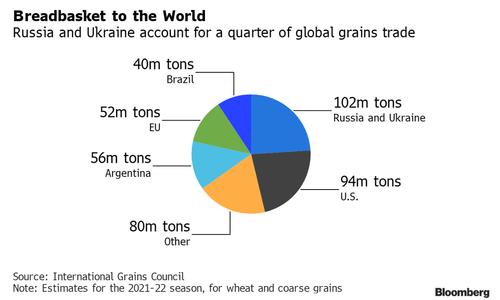
The invasion of Ukraine and the resulting Western sanctions have curtailed exports of grains from the region to the rest of the world. Also, there’s a risk that at least 33% of farmland in Ukraine may go unplanted this spring because of the ongoing conflict. This will undoubtedly impact harvest yields later this year.
CF pointed out that low global grains stocks-to-use ratios have driven up corn, wheat, and other grains futures prices to the highest in decades as investors evaluate extreme tightness in markets.
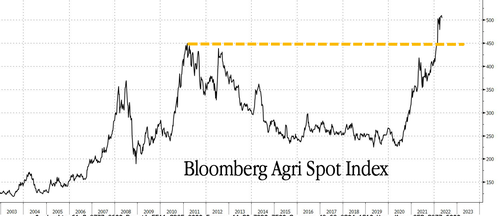
The fertilizer company also said, “global nitrogen inventory remains extremely tight … global supply continues to be limited by curtailments in Europe and Asia due to high energy costs, ongoing restrictions on exports of certain nitrogen products from Egypt, Turkey, and China, and obstacles to nitrogen exports from Russia related to the direct and indirect impact of various sanctions as well as government-imposed export limits.”
Tight nitrogen inventory means prices will remain elevated.
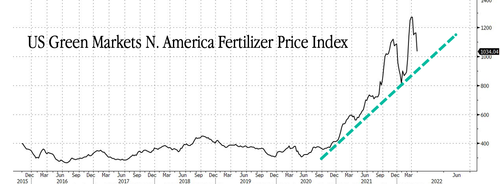
Another top fertilizer company warned about crop nutrient supply disruptions.
Canada-based Nutrien Ltd.’s chief executive officer Ken Seitz told investors on Tuesday during a conference call that fertilizer supplies globally will be tight through 2023.
Two of the largest fertilizer companies in the world are warning about dwindling food and fertilizer supplies as this could indicate a global food crisis is ahead. The Rockefeller Foundation and Goya Foods CEO Bob Unanue have already sounded the alarm.
END
Nationwide Baby Formula Shortage Hits “Shocking” Levels, Sparking Panic Among Parents
FRIDAY, MAY 06, 2022 – 11:20 AM
Authored by Jack Phillips via The Epoch Times,
A nationwide shortage in baby formula is worsening, according to a new analysis, as parents have expressed alarm over the worrying trend.

At retail locations across the United States, about 40 percent of the top-selling infant formula products were not in stock for the week ending April 24, said Datasembly. The company said that it tracked baby formula stock at more than 11,000 stores nationwide.
“This is a shocking number that you don’t see for other categories,” Ben Reich, CEO of Datasembly, told CBS News.
“We’ve been tracking it over time and it’s going up dramatically. We see this category is being affected by economic conditions more dramatically than others,” Reich added.
Previously, drugstore chains like Walgreens and CVS have announced they would limit how many baby formula products each shopper can purchase at a given time.
In a statement, Reich cited inflation, product recalls, and supply chain shortages as why there is “an unprecedented amount of volatility for baby formula.” And he believes that the shortages will continue in the near future.
“We expect to continue to see the baby formula category being dramatically affected by these conditions,” Reich said.
“Baby formula stock, which has been one of the more affected categories so far in 2022, and one that will continue to demonstrate higher than average out-of-stock levels.”
Meanwhile, some parents have expressed alarm on social media about the apparent lack of infant formula on shelves.
“If the [mainstream media] can talk about the toilet paper shortage ever [sic] hour, they should be talking about the baby formula shortage at least,” Danielle Miller, a mother, wrote on Twitter last week.
“We ended [up] finding the Amazon brand online but not everyone is so lucky to be able to feed that. Please share. This is every store!”
“The baby formula shortage is unreal!” GET THESE BABIES SOME FOOD!” another mother wrote on Twitter along with a photo of empty shelves, adding that “it’s a crisis all over.”
Another parent, Irene Anhoeck of San Francisco, told local media that “we’ve noticed it being difficult to find maybe a couple months ago—two, three months ago—and then just recently we can’t find it.” She added, “We’ve tried all the local Targets. We checked Costco, Costco online, Walgreens, Long’s. Can’t find it anywhere.”
In February, a major baby formula producer, Abbott Nutrition, recalled numerous lots of its products following reports of bacterial illnesses in infants. Last week, the U.S. Food and Drug Administration issued a notice to consumers telling them not to consume any products manufactured at Abbott’s facility in Sturgis, Michigan, over concerns of contamination.
END
VACCINE IMPACT
FDA Approves Killer COVID Drug for Babies
May 5, 2022 4:41 pm

While we have focused more on the COVID-19 vaccines that have created more deaths and injuries than all other FDA-approved vaccines for the previous 30 years, the other killer COVID drug currently being administered to the public is Remdesivir, with the brandname of “VEKLURY.” This drug, which was originally developed for ebola but never approved because it was so dangerous, has a history of scandals and many thousands of deaths since it was given an EUA (emergency use authorization) by the FDA, and then in October of 2020 it was fully approved by the FDA as a treatment for adults with COVID-19. To get the original EUA by the FDA, they had to attack existing drugs in the market that were already being proven as safe and effective against COVID-19 symptoms, such Ivermectin and hydroxychloroquine. A reasonable estimate of deaths caused by this killer drug worldwide would number in the millions. In September of 2021, Attorney Thomas Renz released to the public statistics on Remdesivir that a whistleblower had given to him from the CMS (Centers for Medicare & Medicaid Services) database, and the statistics were truly horrifying in terms of how many people were dying after taking this drug, which was over 25% of the patients. And now, the FDA has just approved this killer drug to be used with children, and babies as young as 28 days old.
Michael Every
Michael Every on the day’s most important topics
Rabo: The Last Thing The Polarized US Needs Is A Spike In Food Prices And A Collapse In 401Ks… It’ll Probably Get Both
FRIDAY, MAY 06, 2022 – 08:23 AM
By Michael Every of Rabobank
“Isn’t it rich? Are we a pair?
Me here at last on the ground, You in mid-air…
Where are the clowns?”
Rarely does one make a market call chanting terrace-like, “You don’t know what you’re doing!” to those who thought the Fed ‘hit the right note’ or ‘threaded the needle’ Wednesday – and so bought stocks AND bonds AND commodities AND sold the US dollar – and then see it completely vindicated within 24 hours. I should buy a lottery ticket. Or an NFT, which is the same thing but doesn’t fund good causes.
Yesterday was a market bloodbath. The S&P was -3% and the NASDAQ -5%, Treasury yields surged and bear-steepened the curve (2s +8bp, 10s +11bp to 3.04%), the dollar hit a 20-year high on DXY, with the next technical level all the way up at 120(!); gold and crypto slumped; and key commodities went up. Note the one variable that keeps doing just one thing.
And if you think the US was gloomy and the Fed feeling the pressure, allow me to introduce the damp, overcast UK, where the Bank of England raised rates 25bps but was split three ways between don’t hike, do 25, and do 50. The Old Lady of Threadneedle Street did no needle-threading, but rather said the UK faces recession and inflation of 10%, and overall misery for years. GBP was smacked like a Tory Council (as local election results trickle in), down from 1.2640 to 1.2340. Perhaps the Bank could have lied and said they were confident the economy was fine and would find a soft landing, like the Fed. Stefan Koopman, speaking of the suddenly bleak UK outlook, underlines he has “sounded this particular alarm bell for months on end.” Indeed, he has been singing “You don’t know what you’re doing!” on the terraces too. He also argues (here) that we have another two 25bps hikes to go and then there will be a pause to assess what has been wrought. Unless, perhaps, GBP keeps doing what it is doing, in which case that view might have to be reassessed(?)
“Isn’t it bliss? Don’t you approve?
One who keeps tearing around, One who can’t move…”
Where are the clowns? Send in the clowns.”
And through all this the BOJ is still wedded to 0.25% 10-year JGB yields paid for with freshly-minted money despite Tokyo CPI at 2.5% y/y. JPY at 130 will soon be JPY at 140 or 150, one might think.
“Just when I’d stopped opening doors,
Finally knowing the one that I wanted was yours.
Making my entrance again with my usual flair
Sure of my lines… No one is there.”
What is the correct response to this? Higher rates? One can argue no. Lower rates. One can also argue no. More state spending? One can argue no. Less state spending? One can also argue no.
Of all the combinations above, the best is arguably higher rates and fiscal stimulus DIRECTED AT INCREASING SUPPLY, NOT DEMAND. If that means friend-shoring, so it’s friend-shore; if it means onshoring, so onshore; a ‘Network of Liberty’, so network; automation, so automate. Just don’t think the supply-side will work itself out while you deal with demand.
Perhaps it’s easier to ignore all this and put a lick of greasepaint on the same old, same old, as markets tried on Wednesday. Similarly, France’s President Macron has renamed his political movement for the second time ahead of next month’s parliamentary elections: the first was from En Marche to La République En Marche, and now that becomes Renaissance. One thing I will say in favor of the new name is that period of European history was all about the supply side, Great Power politics, and mercantilism.
Likewise, in China, the Politburo has reiterated that hard lockdowns are the way to go, and hard questions about them aren’t – even playing the left-wing anthem the Internationale is now out. In which case supply chains won’t be seeing most goods go anywhere globally,… until the actual supply chains themselves go global in response. Within China, Bloomberg reports that property developers trying to sell assets are finding almost no buyers – what a surprise!
“Don’t you love farce? My fault, I fear.
I thought that you’d want what I want… Sorry, my dear!
And where are the clowns? Send in the clowns
Don’t bother, they’re here.”
US officials keep boasting about they are helping kill Russian generals and sink Russian ships. This is dangerously clownish. Yes, everyone knows they are. No, you don’t rub Russia’s face in it in public, because it risks a backlash that will escalate tensions even more.
Yesterday also saw the US announce that it would begin to buy back 60m barrels of oil to refill its Strategic Petroleum Reserve – at higher prices than it sold from it at. Expect oil prices to go even higher. Expect diesel prices to go higher than that. Expect a crushing impact on logistics firms – or immediate pass-throughs to all goods and services to prevent bankruptcy. Expect Russia to have even more money to spend on the war.
Again, what is the best policy response? Probably to hike rates and the dollar until commodities break, and to pledge federal support for massive new energy supply. What is the worst policy response? What every government will –understandably– try to do, which is to cushion the blow fiscally. If that is going to happen then at least help the poorest first and most. Don’t, for example, rush to cancel student loan debt for the 1/3 of Americans who went to college in the hope of earning most, which would boost demand – for some.
Elsewhere, the Supreme Court is hidden behind fences, like the White House recently; the FDA has strictly limited the use of the Johnson & Johnson Covid vaccine over links to heart problems; the New York Times is arguing apartheid South Africa had too much free speech, and implies Elon Musk might turn the US into apartheid South Africa too if he lets Twitter give free reign to people (to voice concerns over Covid vaccines’ links to heart problems ahead of the FDA?); and the FTC is floating an anti-trust case against Twitter now it has new ownership, even though no M&A was involved. The last thing the polarized US needs is a spike in energy and food prices and a collapse in 401Ks. Yet it will arguably have to have one of the two, and it might get both.
“Isn’t it rich? Isn’t it queer?
Losing my timing this late in my career.
And where are the clowns? There ought to be clowns…
Well, maybe next year.”
No need to wait that long. We just saw the RBA’s Statement on Monetary Policy. It noted, “The Board is committed to doing what is necessary to ensure that inflation in Australia returns to target over time. This will require a further lift in interest rates over the period ahead.” So, whatever it takes, mates?
On housing, they say construction has been supported by specific policy measures, which the next government will continue in one form or another –wrongly boosting demand not supply– and the low level of interest rates. Demand for mortgages “has been robust… but broader housing market conditions vary across the country. In Sydney and Melbourne, established housing prices are declining and rental inflation has been subdued. Elsewhere, housing markets are tight, with prices and rents both increasing strongly and the available stock for sale or rent at low levels.” There does not appear to be much dot-joining from the pledge for higher rates to what that implies for the over-leveraged housing market. As such, the SoMP was written by someone wearing ridiculously large red shoes.
Today will probably also see a deeply-bruised market attempt to rally – because it hasn’t learned any lessons yet, and that’s what it does by default.
Helping on its way may be US payrolls, as if we didn’t have enough volatility already. The consensus is 380K. Let’s imagine we get a very strong print – does that mean a further market sell-off? Probably, yes. After all, the Fed would believe they are right to keep ploughing ahead with 50bps hikes – and commodities are still going up. But what if we get a very weak print? One would presume then we see markets try and rally, because the Fed will have to hold off. At which point commodities will go up even more.
Commodities are the supply-side joke flower that squirts water in the demand-focused market’s eye every time they lean in to smell it.
Indeed, anyone humming ‘Send in the Clowns’ today needs to be doing it ironically, like The Krusty Comeback Special – with schmaltz by the bowlful. I am just not sure markets are making a special comeback.
END
7. OIL ISSUES
end
You simply cannot make this up!!!!
8 EMERGING MARKET& AUSTRALIA ISSUES
Australia//// NEW ZEALAND/ SOUTH AFRICA/BRAZIL/ARGENTINA/INDIA
END
Your early currency/gold and silver pricing/Asian and European bourse movements/ and interest rate settings FRIDAY morning 7:30 AM
Euro/USA 1.0575 UP .0035 /EUROPE BOURSES //ALL RED
USA/ YEN 130.40 UP 0.075 /NOW TARGETS INTEREST RATE AT .11% AS IT WILL BUY UNLIMITED BONDS TO GETS TO THAT LEVEL…
GBP/USA 1.2345 DOWN 0.0016
Last night Shanghai COMPOSITE CLOSED DOWN 66.20 POINTS UP 2.16%
Hang Sang CLOSED DOWN 791.44 OR 3.81%
AUSTRALIA CLOSED DOWN 2.25% // EUROPEAN BOURSES ALL RED
Trading from Europe and ASIA
I) EUROPEAN BOURSES ALL RED
2/ CHINESE BOURSES / :Hang SANG CLOSED 791.44 OR 3.81%
/SHANGHAI CLOSED UP 20.70 PTS UP 0.58%
Australia BOURSE CLOSED DOWN 2.25
(Nikkei (Japan) CLOSED UP 185.03 PTS OR .68%
INDIA’S SENSEX IN THE RED
Gold very early morning trading: 1881.60
silver:$22.39
USA dollar index early FRIDAY morning: 103.44 DOWN 35 CENT(S) from THURSDAY’s close.
THIS ENDS FRIDAY MORNING NUMBERS
xxxxxxxxxxxxxxxxxxxxxxxxxxxxxxxxxxxxxxxxxxxxxxxxxxxxxxxxxxxxxxxxxxxxxxxxxxxxxxxxxxxxxxxxxxxxxxxxxxxxxxxxxxxxxx
And now your closing FRIDAY NUMBERS 1: 00 PM
Portuguese 10 year bond yield: 2.26% UP 8 in basis point(s) yield
JAPANESE BOND YIELD: +0.249% UP 2 AND 1/2 BASIS POINTS /JAPAN losing control of its yield curve/
SPANISH 10 YR BOND YIELD: 2.24%// UP 10 in basis points yield
ITALIAN 10 YR BOND YIELD 3.15 UP 12 points in basis points yield ./
GERMAN 10 YR BOND YIELD: RISES TO +1.041% IN BASIS POINTS ON THE DAY//
THE IMPORTANT SPREAD BETWEEN ITALIAN 10 YR BOND AND GERMAN 10 YEAR BOND IS 2.15% AND NOW ABOVE THE 3.00% LEVEL WHICH WILL IMPLODE THE ENTIRE ITALIAN BANKING SYSTEM. AT 4% SPREAD THERE WILL BE A HUGE BANK RUN…
END
IMPORTANT CURRENCY CLOSES FOR FRIDAY
Closing currency crosses for Thursday /USA DOLLAR INDEX/USA 10 YR BOND YIELD/1:00 PM
Euro/USA 1.0539 UP 0.0049 or 49 basis points
USA/Japan: 130.28 DOWN .048 OR YEN UP 5 basis points/
Great Britain/USA 1.2363 UP 80 BASIS POINTS
Canadian dollar DOWN 0.0048 OR 48 BASIS pts DOWN to 1.2876
xxxxxxxxxxxxxxxxxxxxxxxxxxxxxxxxxxxxxxxxxxxxxxxxxxxxxxxxxxxxxxxxxxxxxxxxxxxxxxxx
The USA/Yuan, CNY: closed ON SHORE (CLOSED ..DOWN 6.6663
THE USA/YUAN OFFSHORE: (YUAN CLOSED (DOWN)..6.7066
TURKISH LIRA: 14.95 EXTREMELY DANGEROUS LEVEL/DEATH WISH/HYPERINFLATION TO BEGIN.
the 10 yr Japanese bond yield at +0.494
Your closing 10 yr US bond yield UP 3 IN basis points from FRIDAY at 3.093% //trading well ABOVE the resistance level of 2.27-2.32%) very problematic
USA 30 yr bond yield: 3.188 UP 3 in basis points
Your closing USA dollar index, 103.38 DOWN 44 CENT(S) ON THE DAY/1.00 PM/
Your closing bourses for Europe and the Dow along with the USA dollar index closing and interest rates FRIDAY: 12:00 PM
London: CLOSED DOWN 91.91 PTS OR 1.22%
German Dax : CLOSED DOWN 187.70 POINTS OR 1.35%
Paris CAC CLOSED DOWN 91.93 PTS OR 1.44%
Spain IBEX CLOSED DOWN 90.90 PTS OR 1.07%
Italian MIB: CLOSED DOWN 217.56 PTS OR 0.92%
WTI Oil price 110.92 12: EST
Brent Oil: 113.09 12:00 EST
USA /RUSSIAN /// RUBLE FALLS TO: 69.01 DOWN 2 RUBLES/DOLLAR
GERMAN 10 YR BOND YIELD; +1.139
CLOSING NUMBERS: 4 PM
Euro vs USA: 1.0543 UP .0004 OR UP 4 BASIS POINTS
British Pound: 1.2334 DOWN .0029 or 29 basis pts
USA dollar vs Japanese Yen: 130.58 UP .254//YEN DOWN 25 BASIS PTS
USA dollar vs Canadian dollar: 1.2900 UP .0072 (CDN dollar DOWN 72 basis pts)
West Texas intermediate oil: 110.34
Brent OIL: 112.81
USA 10 yr bond yield: 3.125 UP 6 points
USA 30 yr bond yield: 3.216 UP 6 pts
USA DOLLAR VS TURKISH LIRA: 14.95
USA DOLLAR VS RUSSIA///USA/ ROUBLE: 69.40 UP 2.4 ROUBLES (ROUBLE DOWN 2.4 ROUBLES/USA
DOW JONES INDUSTRIAL AVERAGE: DOWN 96.89 PTS OR 0.29%
NASDAQ 100 DOWN 157.02 PTS OR 1.22%
VOLATILITY INDEX: 30.02 DOWN 1.17 PTS (3.75%)
GLD: 175.42 DOWN 0.29 PTS OR 0.17%
SLV/ 20.66 DOWN .12 PTS OR 0.56%
end)
USA trading day in Graph Form
Stocks Suffer Longest Losing Streak In 10 Years, Long-Bond Battered As Fed-Cred Crumbles
FRIDAY, MAY 06, 2022 – 04:01 PM
Absolute chaos intraday in stocks this week… and for a brief period today, there was hope that things would ‘get back to even’ magically on the week… But all that hope evaporated after Kashkari’s comments (which briefly lifted stocks back to unch) faded into the ether and stocks pushed back towards the lows of the day and week (before a late buying panic)…

The machines worked extremely hard in the last few minutes of the day to try and get the S&P into the green for the week – anything to avoid “the worst losing streak since 2011”
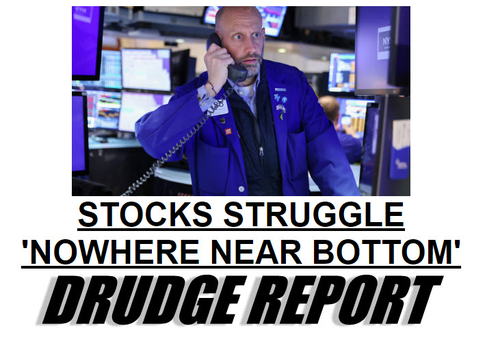
As BofA’s Hartnett said: “Paralysis rather than panic best describes investor positioning.”
S&P 4131.9 was last week’s closing level…just a coincidence!
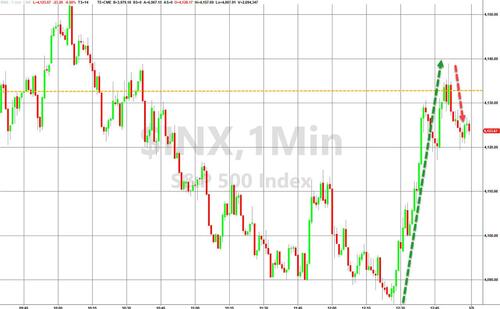
This is the S&P 500’s longest weekly losing streak since June 2011.
VIX was also chaotic this week…
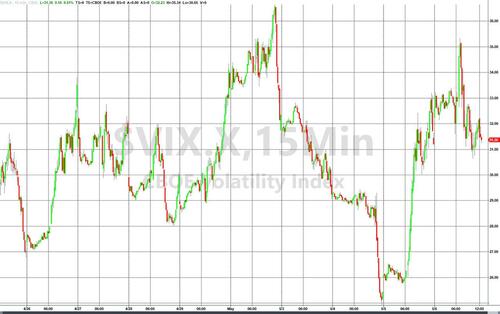
Here’s why – equity market liquidity is near record lows…
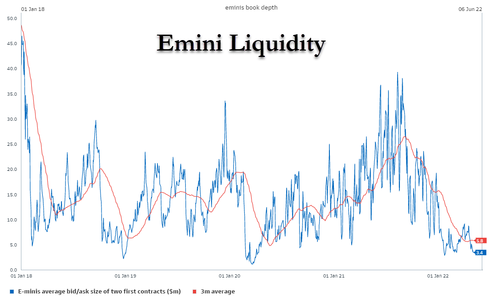
“The mess we’re seeing in the market is about liquidity,” explained Mohamed El-Erian.
“I’m willing to put my neck out and say we have mostly priced in interest rate risk.
We haven’t priced liquidity risk, we haven’t priced credit risk, we haven’t priced market functioning risk.
We are still in the process of pricing it.
The days of abundant and predictable liquidity are gone.”
The market’s message to Powell’s ‘Soft Landing’ narrative this week…
All the majors made new cycle lows…

FANG stocks crashed almost 10% from the post-FOMC spike…

Source: Bloomberg
But while stocks looked ‘unch’ on the week, the bond market saw a dramatic change of tone with the long-end battered and short-end bid…
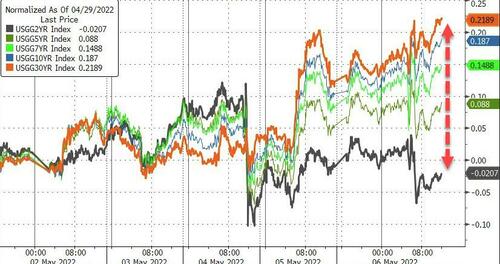
Source: Bloomberg
…massively steepening the yield curve…
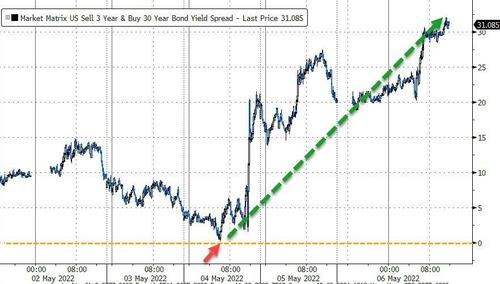
Source: Bloomberg
The entire yield curve is above 3.00% from 3Y out…

Source: Bloomberg
‘Real’ yields surged on the week with 10Y real back above zero…

Source: Bloomberg
The dollar managed gains this week, pushing up against 20 year highs, amid some extreme swings around The Fed…

Source: Bloomberg
Crypto had another down week…

Source: Bloomberg
With Bitcoin leading the drop (back below $36k), as the correlation between the major crypto and the big tech stock index has reached basically ‘1’…
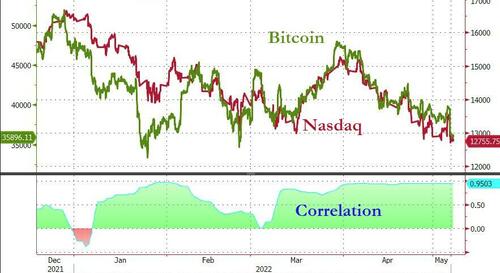
Source: Bloomberg
On the commodity side, things were mixed with crude surging once again (as Biden started buying and EU oil embargo threats were tossed around). On the other side, copper was the biggest loser, as fears over China’s economic growth continues…
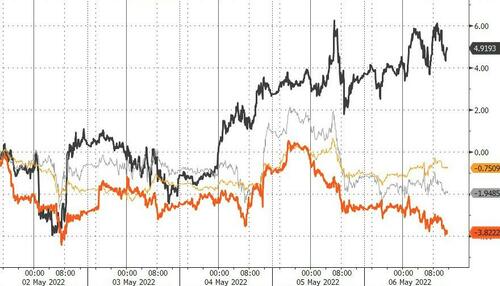
Source: Bloomberg
Gold was unable to hold $1900…

NatGas had a wild ride this week, soaring to within a tick of $9 and plunging today…

Oil is back above Biden SPR levels…
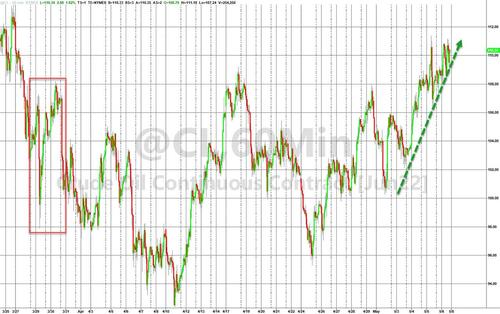
And Retail gas prices are back above Biden SPR levels…

Source: Bloomberg
Finally, we give the last word back to Mohamed El-Erian, who warns that The Fed has a trust problem with financial markets and the nation over inflation.
“It has a credibility issue with the American people and that is why chair (Jerome) Powell chose to address the American people at the beginning of his press conference” on Wednesday, the chair of Gramercy Fund Management and former chief executive officer of Pimco, said on Bloomberg Television’s The Open on Friday. “It increasingly has a problem with the marketplace.”
El-Erian added that “it is essential that the Fed regain credibility. It will not do so until it does what the ECB did last week, tell us why the inflation forecasts were so wrong for so long and how to improve the inflation methodology.”
“You cannot come on TV and speak about all the uncertainties and then rule out a certain policy response — 75 basis points,” El-Erian said. “We don’t know enough about the path of inflation to rule out certain policy actions at this point.”
And if you need to visualize The Fed’s loss of credibility, here it is… Volatility across every asset-class is surging…

Source: Bloomberg
Get back to work Mr.Powell!
END
I) /MORNING TRADING/FOMC
A MIXED BAG!
April Payrolls Rise More Than Expected But Wage Growth Slows And Participation Rate Drops
FRIDAY, MAY 06, 2022 – 08:35 AM
With bulls hoping and praying for a terrible payrolls print – ideally something in the mins 1 million range – and for a big slowdown in wage growth, moments ago the BLS reported a mixed bag for April data, with headline payrolls rising 428K, above the 380K expected (which is in the “good news is bad news” camp), however at the same time average hourly earnings rose 0.3%, below the 0.4% expected (and 0.5% March increase) while the unemployment rate was flat at 3.6%, above the 3.5% expected (both of which are “bad news is good news”).
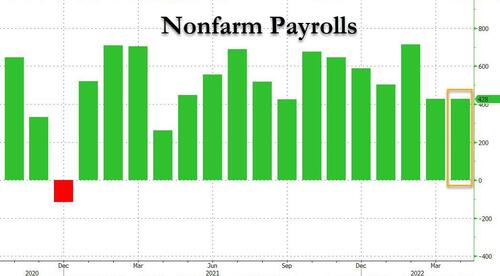
Amusingly, the March payroll print was downward revised to 428K from 431K, the exact same as the March print. Looking further back, the change in total nonfarm payroll employment for February was revised down by 36,000, from +750,000 to +714,000, and the change for March was revised down by 3,000, from +431,000 to +428,000. With these revisions, employment in February and March combined is 39,000 lower than previously reported.
Total payrolls are now about 1.2 million lower than the peak hit before the pandemic. At the April hiring pace, that gap will be made up by July.
The unemployment rate was flat at 3.6%, above consensus expectations of a drop to 3.5%.

Among the major worker groups, the unemployment rates for adult men (3.5 percent), adult women (3.2 percent), teenagers (10.2 percent), Whites (3.2 percent), Blacks (5.9 percent), Asians (3.1 percent), and Hispanics (4.1 percent) showed little or no change over the month. It is worth noting that the overall unemployment rate is at pre-covid levels, while the rate for blacks and hispanics is now even better than pre-covid.
Curiously, even as the unemployment rate was flat, the labor force participation rate actually declined from 62.4% to 62.2%, a move that will disappoint the Fed which has been pushing for an “inclusive” boost to the labor force. The drop was due to a 363K drop in the civilian labor force offset by a 115K increase in the civilian population.
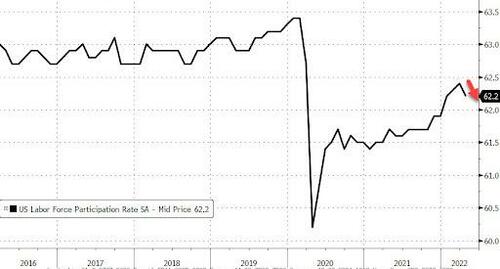
Looking at wages, average hourly earnings for all employees on private nonfarm payrolls rose by 10 cents, or 0.3 percent, to $31.85 in April, below the 0.4% expected. Over the past 12 months, average hourly earnings have increased by 5.5 percent, in line with expectations.
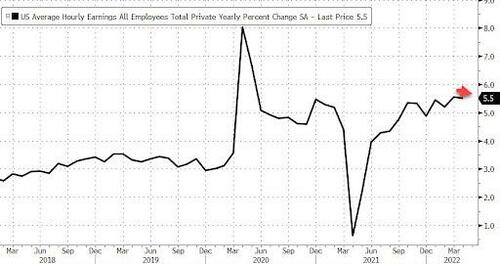
The average workweek for all employees on private nonfarm payrolls was unchanged at 34.6 hours in April, below the 34.7 expected. In manufacturing, the average workweek for all employees fell by 0.2 hour to 40.5 hours, and overtime held at 3.4 hours. The average workweek for production and nonsupervisory employees on private nonfarm payrolls was unchanged at 34.1 hours.
Some more details from the Household Survey:
- The number of persons employed part time for economic reasons was little changed at 4.0million in April and is down by 357,000 from its February 2020 level. These individuals, who would have preferred full-time employment, were working part time because their hours had been reduced or they were unable to find full-time jobs.
- The number of persons not in the labor force who currently want a job was little changed at 5.9 million in April. This measure is above its February 2020 level of 5.0 million. These individuals were not counted as unemployed because they were not actively looking for work during the 4 weeks preceding the survey or were unavailable to take a job.
- Among those not in the labor force who wanted a job, the number of persons marginally attached to the labor force increased by 262,000 in April to 1.6 million. These individuals wanted and were available for work and had looked for a job sometime in the prior 12 months but had not looked for work in the 4 weeks preceding the survey. Discouraged workers, a subset of the marginally attached who believed that no jobs were available for them, numbered 456,000 in April, little different from the prior month.
- In April, 7.7 percent of employed persons teleworked because of the coronavirus pandemic, down from 10.0 percent in the prior month. These data refer to employed persons who teleworked or worked at home for pay at some point in the 4 weeks preceding the survey specifically because of the pandemic.
- In April, 1.7 million persons reported that they had been unable to work because their employer closed or lost business due to the pandemic–that is, they did not work at all or worked fewer hours at some point in the 4 weeks preceding the survey due to the pandemic. This measure is down from 2.5 million in the previous month. Among those who reported in April that they were unable to work because of pandemic-related closures or lost business, 19.0 percent received at least some pay from their employer for the hours not worked, little different from the prior month.
- Among those not in the labor force in April, 586,000 persons were prevented from looking for work due to the pandemic, down from 874,000 in the prior month.
Turning to the Establishment survey, we find the following:
- Employment in leisure and hospitality increased by 78,000 in April. Job growth continued in food services and drinking places (+44,000) and accommodation (+22,000). Employment in leisure and hospitality is down by 1.4 million, or 8.5 percent, since February 2020.
- Manufacturing added 55,000 jobs in April. Employment in durable goods rose by 31,000, with gains in transportation equipment (+14,000) and machinery (+7,000). Nondurable goods added 24,000 jobs, with job growth in food manufacturing (+8,000) and plastics and rubber products (+6,000). Since February 2020, manufacturing employment is down by 56,000, or 0.4 percent.
- Employment in transportation and warehousing rose by 52,000 in April. Within the industry, job gains occurred in warehousing and storage (+17,000), couriers and messengers (+15,000), truck transportation (+13,000), and air transportation (+4,000). Employment in transportation and warehousing is 674,000 above its February 2020 level, led by strong growth in warehousing and storage (+467,000) and in couriers and messengers (+259,000).
- In April, employment in professional and business services continued to trend up (+41,000). Since February 2020, employment in the industry is up by 738,000.
- Financial activities added 35,000 jobs in April, led by a gain in insurance carriers and related activities (+20,000). Employment also rose in nondepository credit intermediation (+6,000) and in securities, commodity contracts, and investments (+5,000). Employment in financial activities is 71,000 higher than in February 2020.
- Health care employment rose by 34,000 in April, reflecting a gain in ambulatory health care services (+28,000). Employment in health care is down by 250,000, or 1.5 percent, since February 2020.
- Employment in retail trade increased by 29,000 in April. Job gains in food and beverage stores (+24,000) and general merchandise stores (+12,000) were partially offset by losses in building material and garden supply stores (-16,000) and health and personal care stores (-9,000). Retail trade employment is 284,000 above its level in February 2020.
- In April, wholesale trade employment rose by 22,000. Employment in the industry is down by 57,000, or 1.0 percent, since February 2020.
- Mining added 9,000 jobs in April, with a gain in oil and gas extraction (+5,000). Mining employment is 73,000 higher than a recent low in February 2021.
- Employment showed little change over the month in other major industries, including construction, information, other services, and government.
And visually:
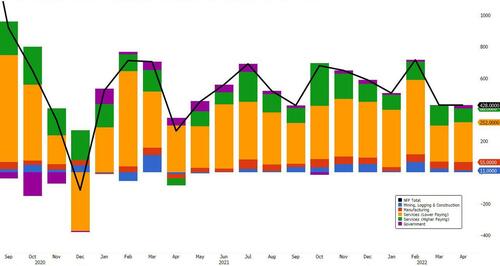
Sources of strength in the print was employment in leisure and hospitality increased by 78,000 in April. Manufacturing added 55,000 jobs — much more than expected. Employment in transportation and warehousing rose by 52,000 in April.
Commenting on the report, Randy Kroszner, economics professor at the University of Chicago Booth School of Business and former Fed governor, tells Bloomberg TV that lots of people are still unsure of entering the labor force.
“That’s going to be a continuing constraint on growth because you’re just not going to see as much labor force participation and that’s going to continue wage pressure.”
II)USA data
IIB) USA COVID/VACCINE MANDATES
end
iiia) USA inflation//SHIPPING commentaries//LOG JAMS//
IIIB) USA ECONOMIC STORIES
This is a very important story as it indicates that the USA bond market is breaking
(zerohedge)
Bond Market Is Breaking: The Last Three Times 30Y Yields Jumped More, The Fed Intervened
THURSDAY, MAY 05, 2022 – 10:03 PM
Some concerning observations about the state of the bond market from JPMorgan’s Jay Barry (full note available to pro subscribers in the usual place).
We argued yesterday that the sharp decline in front-end yields was exaggerated by the unwind of speculative short positions, but we did not expect for that move to nearly fully reverse today as Treasury yields rose 11-16bp. Given this reversal, it’s tempting to say the market is coalescing on our view; however, we do not think this represents a more hawkish reassessment of yesterday’s FOMC meeting, as the long-end led the way to higher yields.
Notably, there have only been 6 instances over the last decade in which 30-year bond yields rose more than today: the top 3 were all amid the worst of market dysfunction in March 2020 which forced the Fed to intervene in unprecedented fashion, the fourth was the day after the presidential election in 2016, the fifth was a stronger-than-expected payroll release on a low-liquidity Friday around the July 4th holiday in 2013, and the sixth was in December 2015 when the ECB disappointed market’s expectations for additional stimulus

Accordingly, we think it’s critical to explore the drivers of this historic move.
First, it’s hard to say valuations justify this bearish steepening. Over a longer period, when the Fed is on the move, the curve tends to trade counter directionally, flattening as yields rise, and vice versa. As a result, the curve has completely decoupled from the market’s Fed’ expectations: over the last 6 months, 2-year Treasury yields have explained about 93% of the variation in the 5s/30s curve, and given these moves, the curve appears about 14bp too steep (Exhibit 2).

Second, we’ve argued lately that the liquidity backdrop is relatively weak: as we showed yesterday, Treasury market depth has been sitting at levels only seen during the worst of the GFC in late-2008/early-2009 and the COVID-19 pandemic in March 2020. This paints a weaker picture on Treasury market liquidity than the presentation by TBAC. Ten-year Treasury market depth remains near the lowest levels since March 2020. Now poor liquidity in itself does not cause this move, but can be an accelerant in the face of other factors. It’s likely this has been exaggerated by cyclical dynamics, as liquidity tends to weaken in the days leading up to the monthly employment report: this could be exaggerated by the calendar configuration, as today falls the day after the FOMC and the day before the April employment report (Exhibit 3).

Third, risk appetite is light: we’ve highlighted that investors have used the move to higher yields to reduce risk, and Exhibit 4 shows that the share of neutrals in our Treasury Client Survey have been on the rise throughout 2022, matching the highest share since early-March 2020, and the upper end of the range we’ve seen over the past decade. This matters because Treasury is set to auction about $105bn in 10-year Treasury equivalents next week, certainly smaller than the last few months, but still the largest weekly concentration of duration supply over the course of this month.
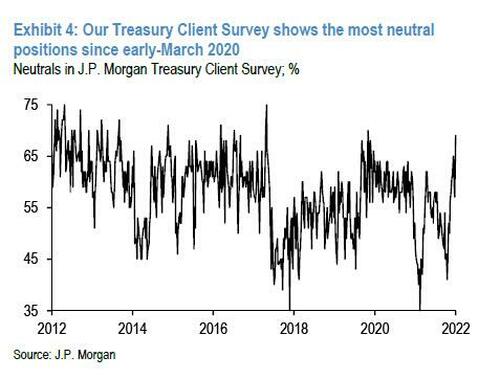
end
Feds take emergency action to delay water releases from Lake Powell as the megadrought is creating a huge crisis in the western part of the uSA
(zerohedge)
Feds Take Emergency Action To Delay Water Releases From Lake Powell As Megadrought Sparks Crisis
THURSDAY, MAY 05, 2022 – 10:00 PM
The federal government announced Tuesday unprecedented measures to increase the water level in Lake Powell, the second-largest reservoir on the Colorado River. The reservoir, which supplies water and power to millions of people in seven states, has plunged to 24% of total capacity and the lowest level in over half a century.
Amid the worst drought in 1,200 years, the Bureau of Reclamation announced a plan to release approximately 500k acre-feet (kaf) of water from Flaming Gorge Reservoir, located upstream, that will flow into Lake Powell. Another 480k kaf that would have been released from Lake Powell will be retained in the artificial lake on the Utah-Arizona border.
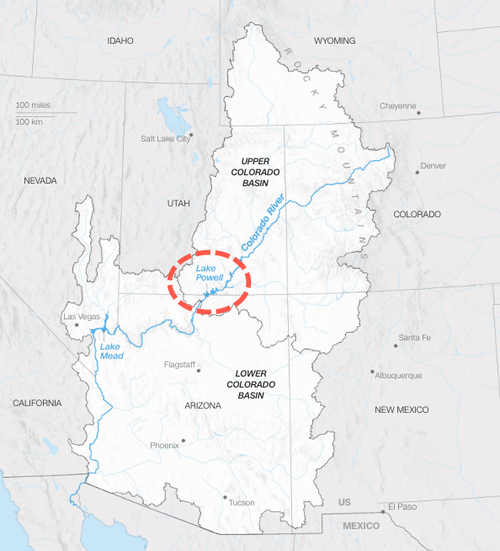
Such an emergency action is in response to Powell’s water surface elevation at 3,522 feet and quickly dropping. A level below 3,490 feet would mean the Glen Canyon Dam hydropower plant would no longer be operational and could disrupt power and water to millions of people.
“The measure protects hydropower generation, the facility’s key infrastructure, and the water supply for the city of Page, Arizona, and the LeChee Chapter of the Navajo Nation,” the federal agency said.
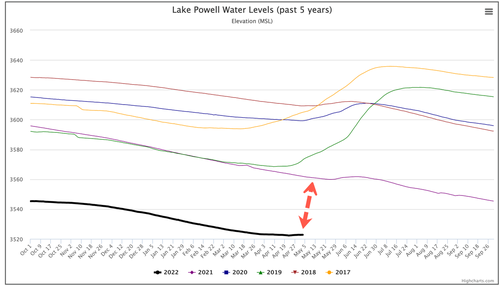
This will buy federal and state officials 12 months as it considers additional measures to prevent Lake Powell from slipping under the disastrous level of 3,490 feet.
“We have never taken this step before in the Colorado River Basin, but the conditions we see today and the potential risk we see on the horizon demand that we take prompt action,” Tanya Trujillo, the Interior Department’s assistant secretary for water and science, told reporters.
CNN spoke with Bryan Hill, general manager of the public power utility in Page, Arizona, compared the water crisis at Lake Powell to judgment day.
“We’re knocking on the door of judgment day … Judgment day being when we don’t have any water to give anybody, Hill previously said.
The decision comes two weeks after federal officials weighed measures to hold back water at the dam to protect the hydropower plant at Glen Canyon Dam. Their action response time of just two weeks suggests a water crisis is underway.

Recently, Tom Buschatzke, Arizona’s top water official, warned of an impending water crisis. He said: “We’re going to have to learn to live with less water.”
With summer in a month and a half, federal government meteorologists are already warning that severe drought conditions could worsen. US Drought Monitor data shows much of the US West is experiencing severe to extreme drought conditions.
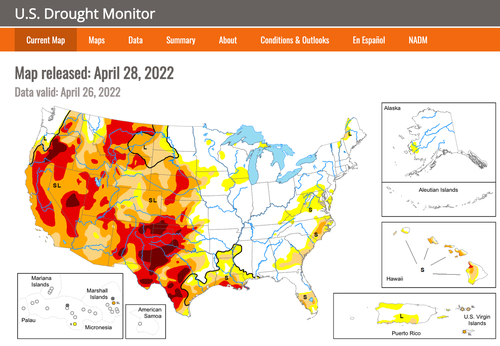
Several counties in Southern California have already declared a water shortage emergency for the first time, restricting residents from outdoor watering. This could broaden to more states that depend on the Colorado River as Lake Powell and Lake Mead (more downstream) experience record low levels. A megadrought in the western part of the country won’t be abating anytime soon.
iv)swamp stories
The King Report (including swamp stories)
| The King Report May 6, 2022 Issue 6754 | Independent View of the News |
| @economics: The Fed was “trying to send a message of sustained expectations for 50 basis point increases,” but “unintentionally gave a very dovish message,” says BlackRock’s Jeffrey Rosenberg https://t.co/R2naVoLB9p Biden administration launches plan to refill emergency oil reserve – CNN The Biden administration plans to seek bids this fall to buy 60 million barrels of crude oil as the first step in a years-long process aimed at replenishing America’s emergency oil reserve, an Energy Department official told CNN… (Is ‘this fall’ after the November midterm elections?) Delivery of the first tranche of 60 million barrels will take place in unspecified future years, the Energy Department official said… Reserves were already sitting at 20-year lows before President Joe Biden promised in late March to release a record-setting 180 million barrels of oil over six months to ease pressure on energy markets. The latest release amounts to a loss of one-third of the oil still left in the SPR… (The Big Guy’s scheme is to deplete the SPR until the November elections and then refill it.) https://www.cnn.com/2022/05/05/energy/spr-biden/index.html We opined in Thursday’ missive that The Big Guy was running low on oil to deplete from the SPR. Can you imagine the MSM and Dem outrage if Trump had performed the same politically charged gambit? Yesterday, the bond market, due to abysmal US Productivity in Q1, created a major problem for the feckless G. William Powell. USMs traded modestly lower during Asian trading but broke lower during the final two hours of Nikkei trading. The decline persisted until the US repo market opened at 7 ET. Someone then drove USMs 24/32 higher in 14 minutes. After a modest respite, USMs rallied modestly. US Productivity Just Crashed by The Most Since 1947 As Labor Costs Explode US Unit Labor Costs surged 11.6% in Q1… And at the same time, business output declined by 2.30% QoQ SAAR…Both of which combine to drive US Productivity crashing 7.5% in Q1 – that is the biggest drop since 1947… https://www.zerohedge.com/personal-finance/us-productivity-just-crashed-most-1947-labor-costs-explode After the release of US Productivity at 8:30 ET, USMs commenced a tumble that took the June 30-year bond contract to 137 22/32, -2 14/32 at 9:54 ET. The US 10-year bond registered 3.03%. The dollar and precious metals were up sharply. The horrendous plunge in Q1 US Productivity removed the hope that inflation could be contained by rising productivity. This implies inflation could continue to run hot, and possibly accelerate in coming quarters. It also suggests that inflation won’t die a natural death and arresting inflation depends on the hapless G. William Powell. The US 30-year bond decisively breached its April low and hit its highest yield since December 2018. The 10-year hit its highest yield since November 2018. This was the last time the Fed tightened. It’s been clear for many years that Fed officials fear spooking the stock market. Yesterday showed the Fed what can happen when you spare the rod and spoil the stock market. Powell’s overt dovishness on Wednesday was intended to prevent a stock market tantrum after a 50bp Fed Funds rate hike. US Q1 Productivity obliterated Powell’s squishy scheme. In effect, Powell elected to save the stock market and allow inflation to persist, maybe increase, for Americans. Somewhere, if he had any sense, Powell would be lamenting his decision to proclaim to the world that he didn’t have the stuff to aggressively move against inflation. If he has any awareness, Powell realizes that his plan to prevent a stock market tumble was negated in one day and now the known world believes he is G. William Miller. With history as a guide, this means Powell will have to shock & awe the markets to disabuse the notion that he is a feckless fiddling Fed CEO while inflation burns. Musk Blasts Soros ‘Dark Money Groups’ Threatening Twitter Advertisers https://t.co/6cKjrfMD0M CDC Tracked Millions of Phones to See If Americans Followed COVID Lockdown Orders Newly released documents showed the CDC planned to use phone location data to monitor schools and churches, and wanted to use the data for many non-COVID-19 purposes, too…and specifically monitor the effectiveness of policy in the Navajo Nation… https://www.vice.com/en/article/m7vymn/cdc-tracked-phones-location-data-curfews @US_FDA: Today, we limited the authorized use of the Janssen #COVID19 Vaccine to those 18+ for whom other auth/approved vaccines are not accessible or clinically appropriate, & to those who elect Janssen because they would otherwise not receive a COVID vaccine. https://go.usa.gov/xudMH @ClayTravis: Just to make it clear where we are: our government mandated 100% healthy people get covid shots provided by for profit companies or lose their jobs & is now telling us that one of the shots they told us to take isn’t safe & has life threatening side effects. Our government also told us two covid shots would keep us from getting or spreading covid, sought to ban anyone who suggested otherwise, before later admitting it neither kept you from getting or spreading covid. Our government also told us it wasn’t safe for our kids to go to school in person — even though kids have a statistically 0% risk from covid — & that we all had to wear masks, including two-year-olds, even though there is no data to support masks making any of us safer. This fall the government will tell you a 5th covid shot will solve all of it. And if you question any of this at all you’re labeled a conspiracy theorist who needs to be investigated by their allies in mainstream media, doxxed, & threatened with cancellation. This is where we are. U.S. intelligence helping Ukraine kill Russian generals -NY Times https://t.co/OUAFDJIWy6 @jasongoepfert: There have been 2 days in the past 25 years when S&P 500 futures were down 3% and 10-year Treasury futures down 1%: October 9, 2008; March 18, 2020 @bespokeinvest: The US Dollar Index is up over 1.2% today. Big rallies in the dollar don’t usually occur when things are running smoothly. The last time the Dollar Index rallied 1% in a day was when all hell was breaking loose in March 2020. Tokyo Inflation (CPI ex-fresh food +1/9% y/y) Hits Fastest Pace in Almost Three Decades – BBG Today – Barring a significant NFP miss, up or down, April NFP should not impact trading for long. G. William Powell has cast his lot; and the known universe knows that he is a squishy Fed CEO. This means Powell is content to greatly lag the inflation curve and hope that inflation will recede without Fed action. This means wages, not NFP, should be the key metric today. If April wages are higher than expected, Mr. Bond could throw another tantrum on fear that a wage-price inflationary spiral has arrived. Powell has bet the Fed and the US economy on inflation dying a natural death. If commodities resume their rally, there is little on the horizon to prevent food and energy inflation from escalating. The Big Guy’s dismal approval ratings will worsen. If wages inflation accelerates, even equities will ‘get it’. The dollar will probably stay buoyant because the BoJ is adamant about inflating; China wants to inflate; and Lagarde is even more craven than Powell. Three Fed officials are slated to speak during trading hours; three will speak in the evening. Will they be more hawkish than they initially intended due to the market revolt against Powell’s squishiness? Maybe they can explain how moving ‘expeditiously’ against inflation equates with a balance sheet increase. ESMs are -5.75 and USMs are +11/32 at 20:10 ET. Expected economic data: April NFP 380k (Whisper # 335k), Mfg 35k, Rate 3.5%, Wages 0.4% m/m, Workweek 34.7, Labor Force Participation Rate 62.5%; March Consumer Credit $25.0B; NY Fed Pres Williams 9:15 ET, Minn Fed Pres Kashkari 11 ET, Atlanta Fed Pres Bostic 15 ET S&P 500 Index 50-day MA: 4373; 100-day MA: 4472; 150-day MA: 4506; 200-day MA: 4491 DJIA 50-day MA: 34,062; 100-day MA: 34,771; 150-day MA: 34,957; 200-day MA: 34,967 S&P 500 Index – Trender trading model and MACD for key time frames Monthly: Trender and MACD are negative – a close above 5125.85 triggers a buy signal Hourly: Trender and MACD are negative – a close above 4547.45 triggers a buy signal Daily: Trender and MACD are negative – a close above 4529.25 triggers a buy signal Hourly: Trender and MACD are negative – a close above 4257.83 triggers a buy signal @IAPolls2022: Joe Biden is now the least popular president (net approval) at this point in office of any president going back to at Truman in 1945, according to the @FiveThirtyEight combined poll tracker https://twitter.com/IAPolls2022/status/1522208764526571520 Russia simulated nuclear missile strikes near the border with NATO (The more desperate Putin gets, the more he will rattle the nuclear saber.) https://t.co/ql4I9gC59x @townhallcom: BIDEN: “25 out of every 100 children in grades kindergarten through senior in high school speak Spanish…and we’ll conquer and honor and lift up all those folks who in fact, are, have gotten in the way.” https://twitter.com/townhallcom/status/1522321805620482048 Liberal group calls for protests at conservative Supreme Court justices’ homes Group says they will visit the homes on May 11 (Where’s the MSM outrage at this intimidation?) https://www.foxnews.com/politics/liberal-group-protests-conservative-supreme-court-justice-homes BLM-Linked Group Targeting SCOTUS Justices’ Homes Offering Stipends to Activists https://t.co/x8YdTnk01T @CatholicVote: “Pro-abortion groups are now threatening to disrupt Catholic churches and to protest outside the homes of Supreme Court justices this Sunday. President Biden must immediately and forcibly condemn these domestic terrorist threats.” https://t.co/cNhncuSUPb Dem Senator Mark Warner, breaking ranks with his party’s leaders, said the Supreme Court leaker should be “prosecuted to the fullest extent of the law.” NY Post Editorial Board: Biden’s ‘most extreme’ MAGA malarkey “This MAGA crowd is really the most extreme political organization that’s existed in American history. Recent American history.”… As we’ve noted, the end of Roe will dent abortion rights in parts of America, but only by putting the issue back into normal politics. Biden’s bid to paint it as the first salvo in a wholesale remaking of America is just a desperate attempt to change the subject from soaring inflation, a virtually open border and rising crime — the problems every poll shows the public cares about most, and every one of them belonging at the door of Democrats’ extremist agenda. https://nypost.com/2022/05/04/joe-bidens-most-extreme-maga-malarkey/?s=02 AG Merrick Garland announced the U.S. Department of Justice is creating an Office of Environmental Justice. https://www.justice.gov/opa/pr/justice-department-launches-comprehensive-environmental-justice-strategy NYT Slammed Over Stealth-Edited, Race-Baiting Musk Smear He “grew up in a bubble of white privilege” in South Africa, he’s just fine with racist or other ‘toxic’ content on Twitter, which they frame as ‘unchecked speech.’… (Where was A. G. Sulzberger reared?) https://www.zerohedge.com/political/nyt-slammed-over-stealth-edited-race-baiting-musk-smear “All tyrannies rule through fraud and force, but once the fraud is exposed, they must rely exclusively on force.” — George Orwell As the SEC Cracks Down on Shady SPACS, CIA Officials get in on the Action Leaders of In-Q-Tel, a CIA-backed venture fund, and retired CIA officials are getting in on the latest stock market trend https://theintercept.com/2022/05/05/cia-venture-capital-inqtel-spac/?s=02 NASA to launch naked pictures of humans to space in hope of ‘attracting aliens’ (Has anyone at NASA seen Twilight Zone episodes?) https://trib.al/KKSl0Nz “Give me a child until he is 7 and I will show you the man.” – Aristotle |
END
Let us close today with this offering courtesy of Greg Hunter
Nuke War Close, FOX Ignores 2000 Mules, Inflation vs Roe
By Greg Hunter On May 6, 2022 In Weekly News Wrap-Ups26 Comments
4.15.22 sinking of Moskva
By Greg Hunter’s USAWatchdog.com (WNW 528 5.6.22)
It is now confirmed by intel sources that the U.S assisted in sinking the prized Russian warship called the Moskva. Sinking a ship is an act of war. Here’s what history says about the U.S. entering into the first world war. “Lusitania, British ocean liner, the sinking of which by a German U-boat on May 7, 1915, contributed indirectly to the entry of the United States into World War I.” Are we close to world war and a war that could very easily escalate into a nuke war? I think we are going to find out sooner than later.
Every mainstream media operation is simply ignoring the new movie “2000 Mules,” which creator Dinesh D’Souza says proves beyond a doubt there was widespread voter fraud in the form of ballot box stuffing in the 2020 Election. Even FOX is ignoring this explosive film. Shame on fake FOX News. The mainstream media is desperate to discredit it and try to totally ignore this earth-shaking revelation of a stolen election and an illegitimate President in the White House.
Looks like the federal abortion case Roe v. Wade is going to be overturned by the Supreme Court. Is this enough to give the Democrats an advantage? Don’t bet on it as Americans will be struggling to survive in a world of staggering inflation, the worst in 40 years. Getting behind killing the unborn is going to be low on the priority list when trying to pay for food and fuel that is exploding in price along with everything else.
Join Greg Hunter as he talks about these stories and more in the Weekly News Wrap-Up for 5.6.22.
(To Donate to USAWatchdog.com Click Here)
After the Interview:
Best-selling author of the Harbinger, Jonathan Cahn, has a new movie out called “Harbingers of Things to Come.” Cahn gives a warning for America and has stunning insight into how to keep America from having the same fate as Israel hundreds of years ago. The parallels between ancient Israel before it fell and America are stunning. Cahn will explain in detail.



[…] by Harvey Organ, Harvey Organ Blog: […]
LikeLike
[…] by Harvey Organ, Harvey Organ Blog: […]
LikeLike